Importing a car is a surprisingly thrilling experience. You get the rush of the search, the gratification of finding your ride, and the surprise of seeing your car for the first time. Yet, many importers are missing out on an awesome experience, and it’s physically going to the port to pick up your car. America’s ports are secretly car enthusiast paradises, and it’s not even hard to join in on the fun.
Most importers just have their cars shipped from the port to their home or business. There’s nothing wrong with this! Your nearest port might be over 1,000 miles away from you. Picking up your own car means taking off from work, having a truck, and taking a road trip. Or, maybe you’ll fly out and drive home. Either way, it’s an involved process, and it’s just easier to hire a shipping company, especially if you import more than one car.
If you have the time, I highly recommend picking up a car yourself. I just got back from a road trip to pick up my new-to-me 1998 MGF roadster that I imported from Japan. You’ll hear about the car and the truck that hauled it in really soon. But first, I want to talk about an experience that most car enthusiasts miss out on.

Buried In Paperwork
Your port adventure begins right before the ship that your car is on leaves its departure port. If you’re importing something from Japan and you bought your car from an exporter, an auction agent, Car From Japan, Be Forward, or similar, you’ll be handed tons of paperwork. You’ll have the Bill of Lading from your carrier, which contains declarations, as well as details about what you’re shipping, what ship it’ll be loaded on, what port it’s going to, and more.
You’ll also get the vehicle’s export certificate and an English translation of its export certificate. You will also likely have an invoice from the firm that you bought your car through. In my case, I received physical documents that were sent to me from Japan, but also digital copies.
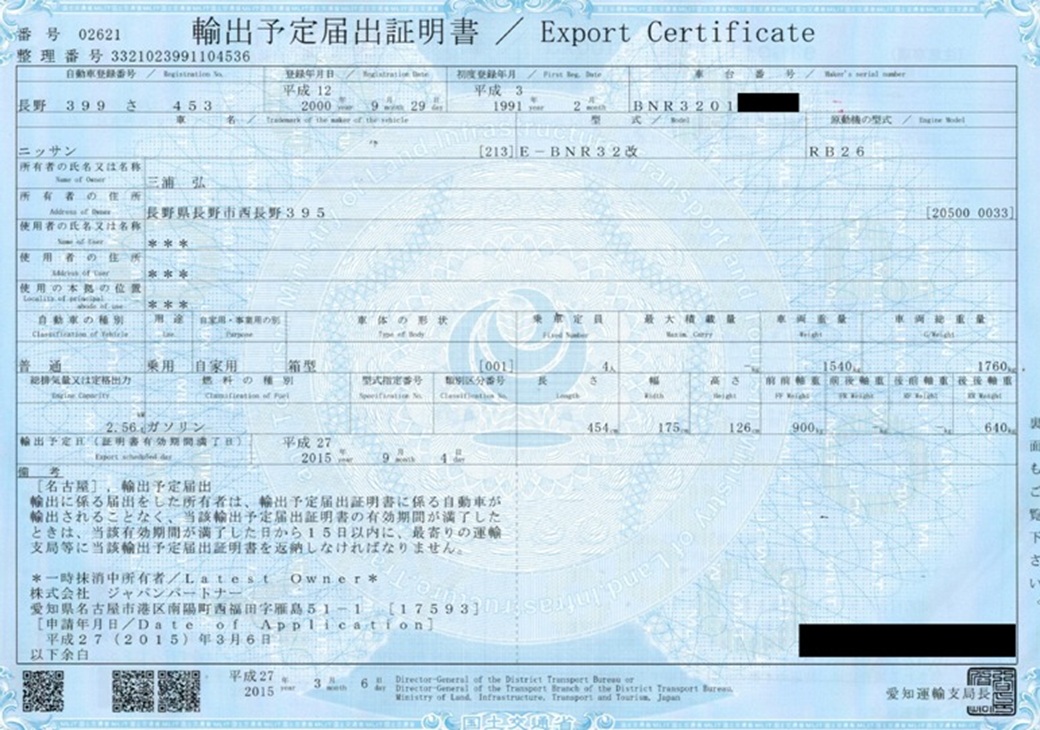
This is when you want to file your Importer Security Filing, also known as the ’10+2′, which informs U.S. Customs and Border Protection about what you’re sending to America. The ISF is pretty easy to do yourself, and there are plenty of websites to help you. This time around, I used TurboISF, which guides you through the entire process. You should be able to file your ISF in minutes! In my case, I needed a copy of my invoice from Be Forward, a copy of my driver’s license, my Social Security number, and a power of attorney form.
What happens next is a long wait. If you’re like me, you can use one of the many online tracking tools to see where the ship is at any given moment. If you’re shipping to Jacksonville, Baltimore, or a similar eastern port, you can expect a transit time of roughly a month or so.
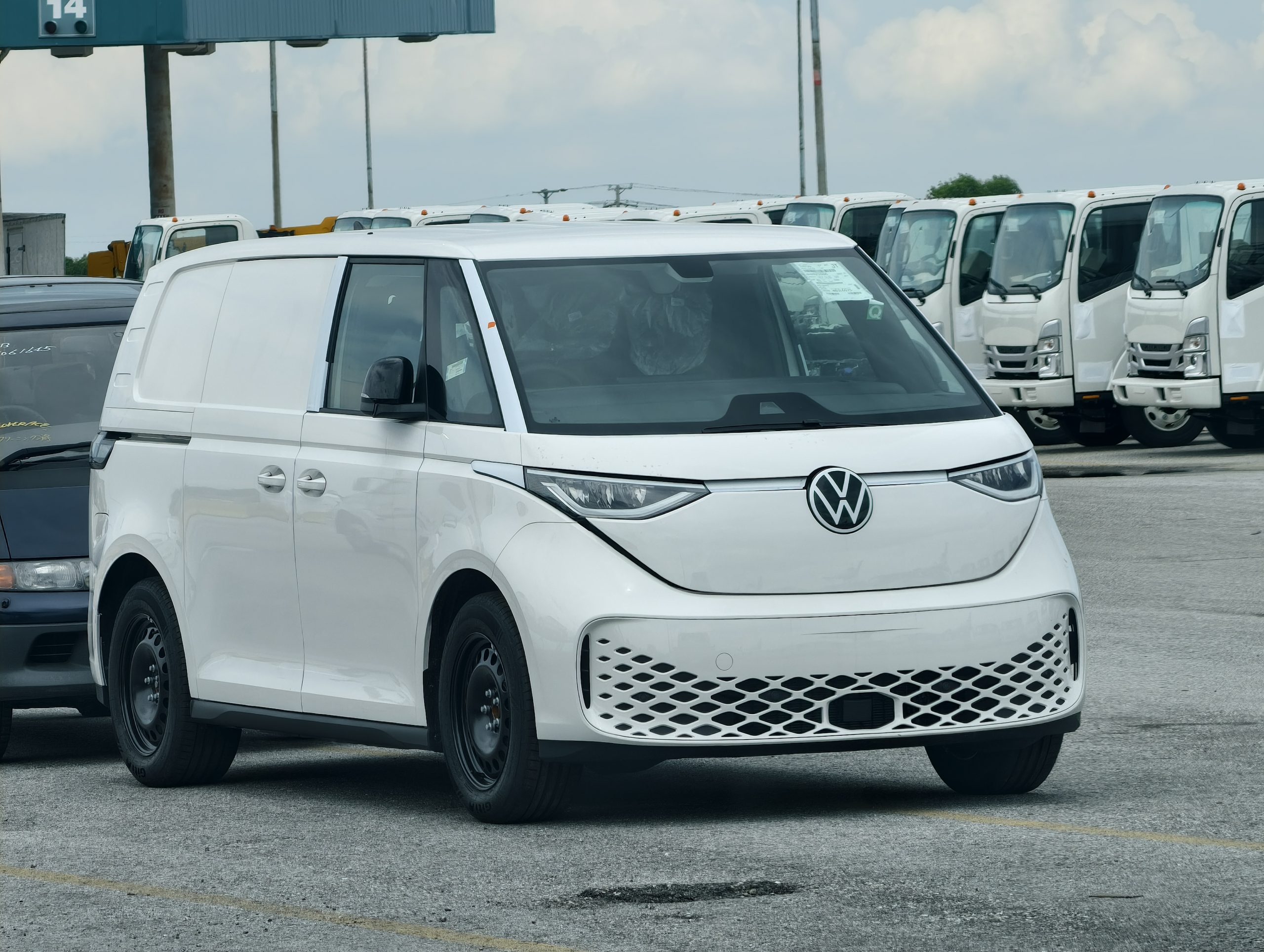
Around a week before your ship lands, you will receive an Arrival Notice from your carrier. This notice will contain details like where in the port your car will be offloaded to, what fees you may owe to the carrier and to the terminal, and who to contact if you need information about pickup times, the status of your cargo being released by the shipping line, and other port details. The contact in the Arrival Notice will likely be a port logistics services company like Norton Lilly International. Here’s where the fun begins.
A lot of mechanisms begin turning after the Arrival Notice. The port services company may require you to overnight your original Bill of Lading before the vehicle can be released by the shipping line. So, you’ll end up sending that document off while paying any fees that may be due. I’ll break down the costs in another piece, but in my experience, these fees have always added up to under $200.
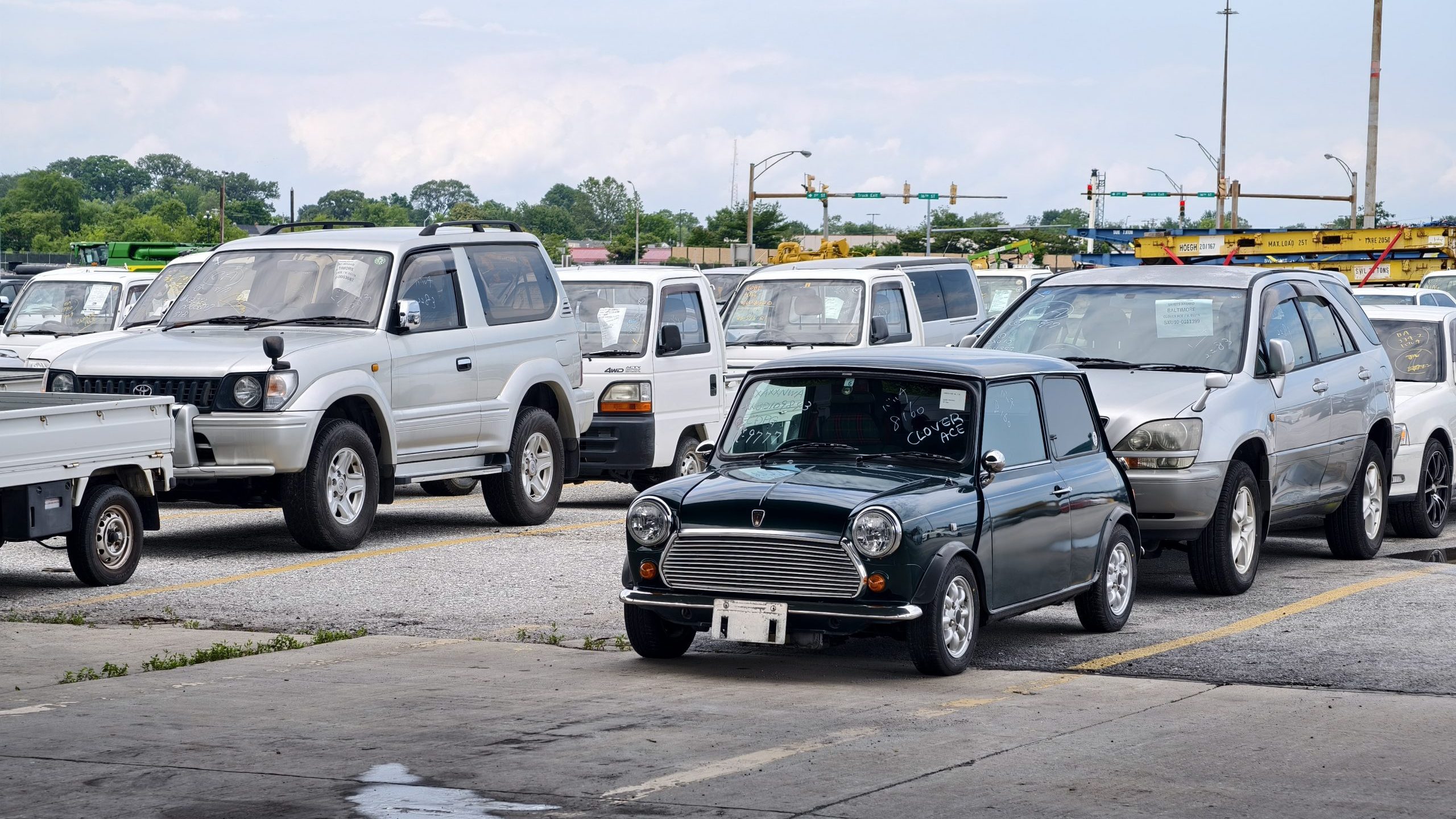

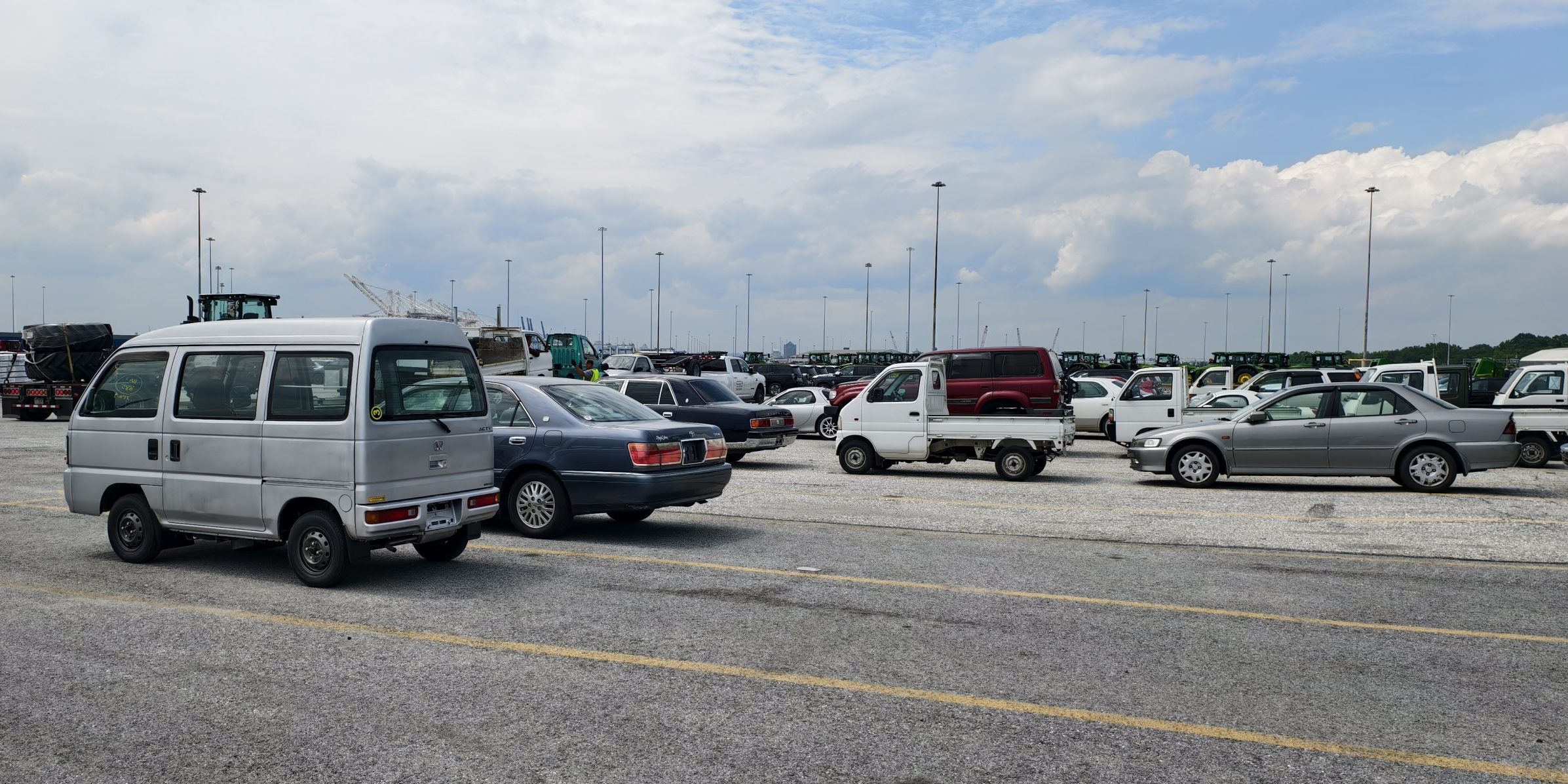
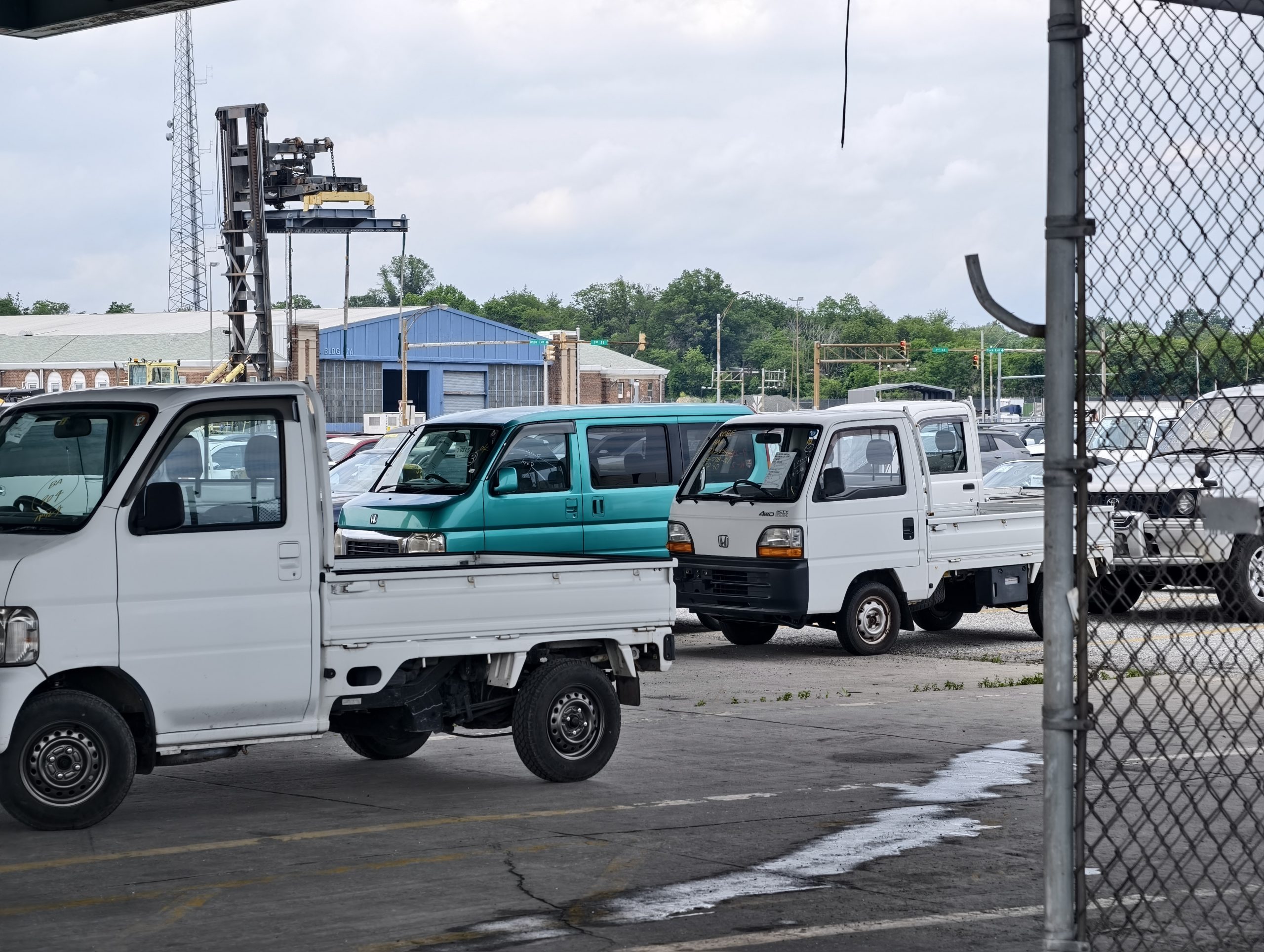
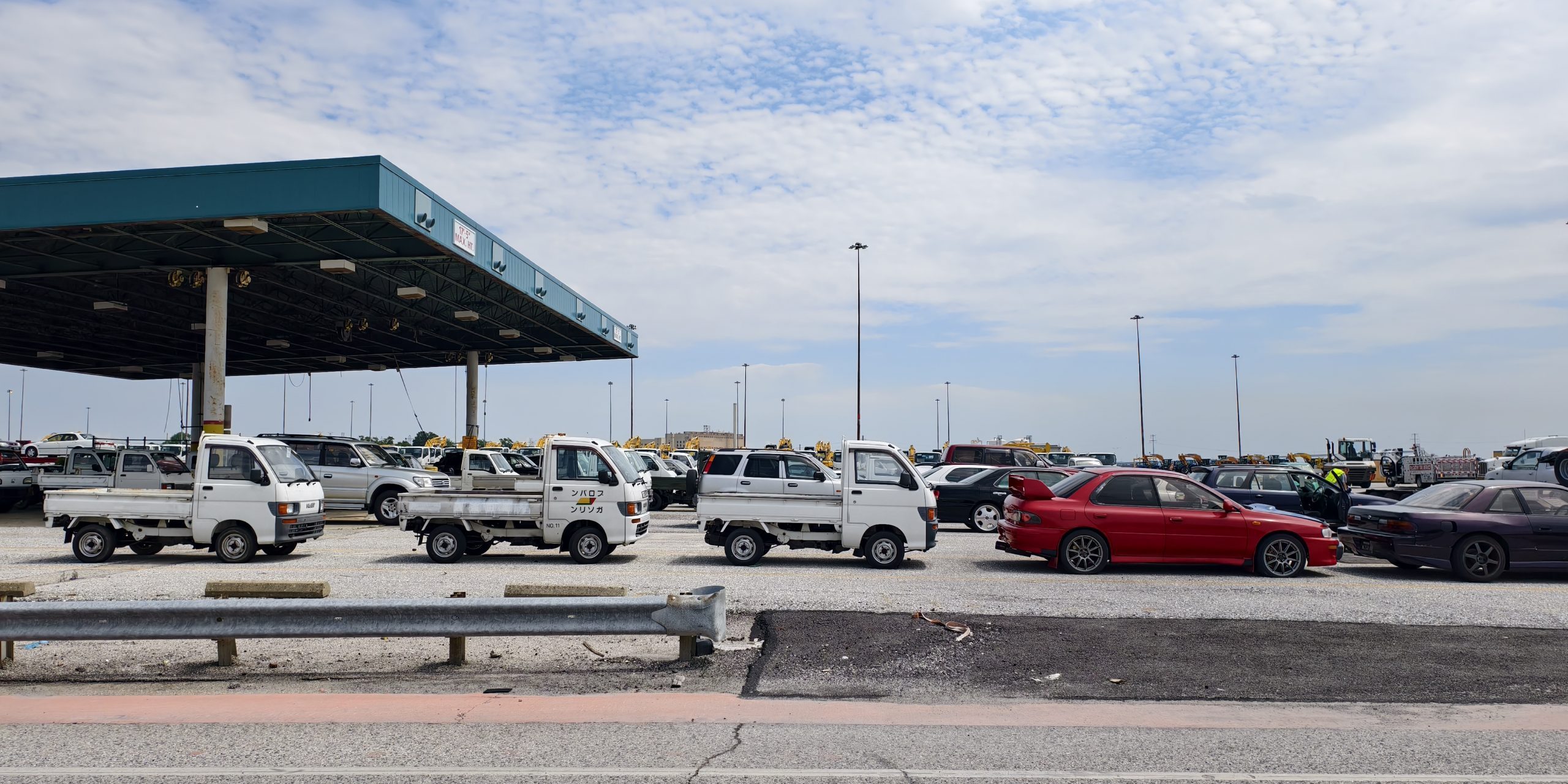
You’ll also want to get the Customs clearance process started. Now, you can either do that yourself by following the brilliant guide that I’ll link here, or you can pay someone to do it for you. I have always taken the latter option. I noticed that TurboISF also has a Customs clearance service, so I sent TurboISF the arrival notice email and a digital copy of my export certificate.
Once your vehicle is both line released and cleared by Customs, you’ll get a bunch of paperwork. You’ll get a Delivery Order, CBP Form 3461 Entry/Immediate Delivery, CBP Form 7501 Entry Summary, and EPA Form HS-7. You’ll need the CBP and EPA forms to register your car, and the Delivery Order is your ticket to actually picking the car up.
Port Quirks

Once you have your line release, Customs release, and Delivery Order, you’re clear to pick your car up, which means extra fun. You’ll have to check with the port about pickup times, number of free days, and when the port is even open. You have a limited number of days to pick up your car before the port starts charging you daily for storage. Thus far, the three cars I have picked up from Baltimore have had seven days of free storage.
Exact details will vary between ports, and what you’re reading here relates to my experiences in picking cars from Baltimore.
One of the quirks that you’ll learn pretty quickly is that the port is open for pickup only during certain hour windows and only during business days. If you’re like a typical American and have the weekend off from work, that’s not going to help you here because not only is the port not open for pickup, but if you call a terminal operator — Ports America, in this case — you are unlikely to get anyone on the phone. So, if you have any questions about exactly where your car is in the port, what times you can pick it up, or other details, you have to call during the workweek.
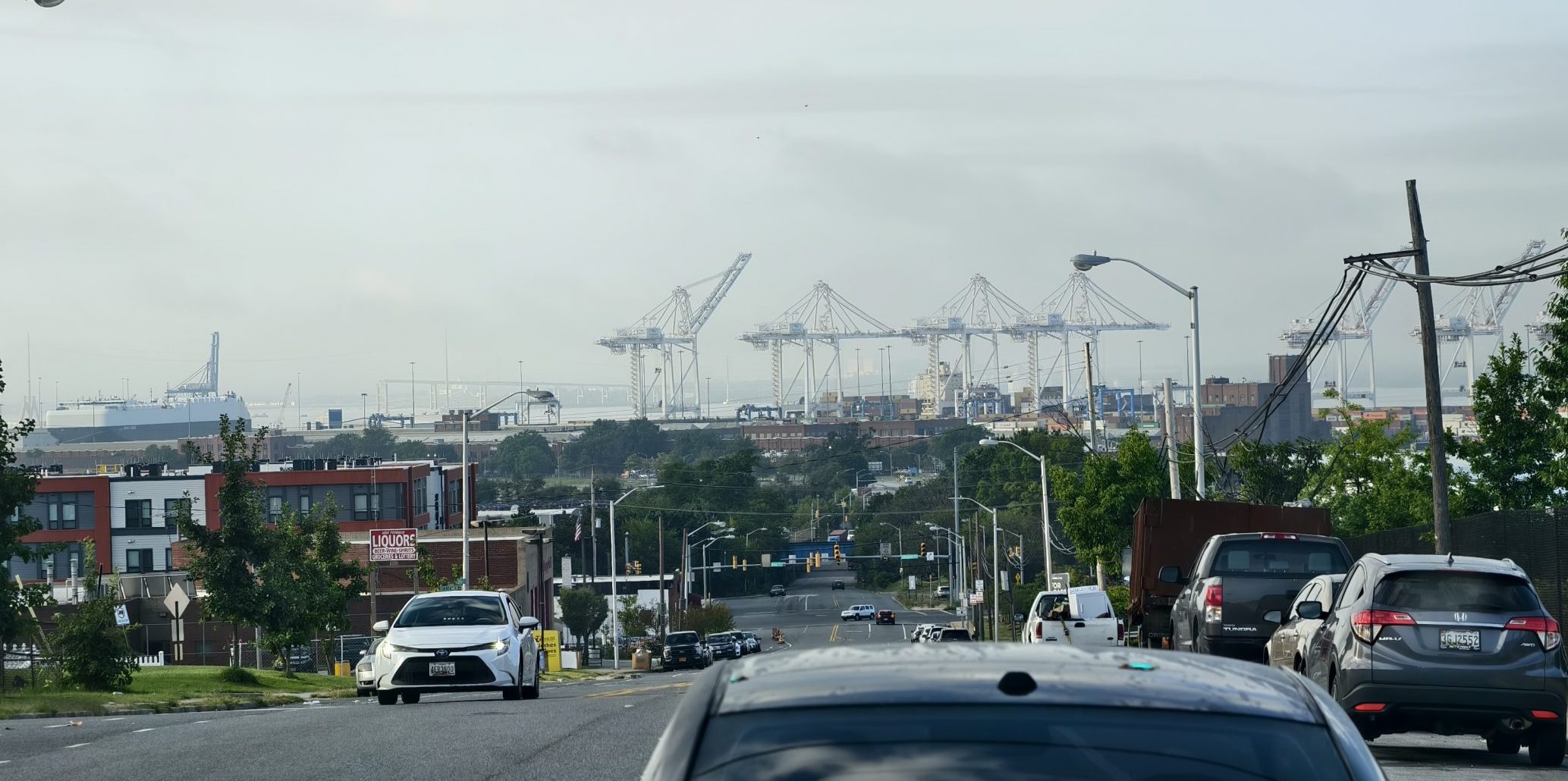
Otherwise, now it’s time to hitch up and drive out to the port. For now, just focus on getting there!
Once you get to the port, you’ll find one more funny quirk, and it’s that you’ll need a Transportation Worker Identification Credential (TWIC) to get through the gate. Now, if you plan on visiting the port often or are a trucker, it’ll probably be worth going through the application process to get a TWIC card. Otherwise, you can hire a port escort, or someone who has a TWIC card whose entire job is to essentially babysit you while you’re in the port.
These escorts aren’t just there for people picking up loads, either. If someone has to come into the secure area of the port to repair something and they don’t have a TWIC, they’ll hire an escort, who will just sit there while they work. Yesterday, a call came over my escort’s radio about someone who needs to spend about five or six hours fixing something in the port. Yep, the escort assigned to that client will just sit around, essentially doing nothing for six hours, and get paid to do it.
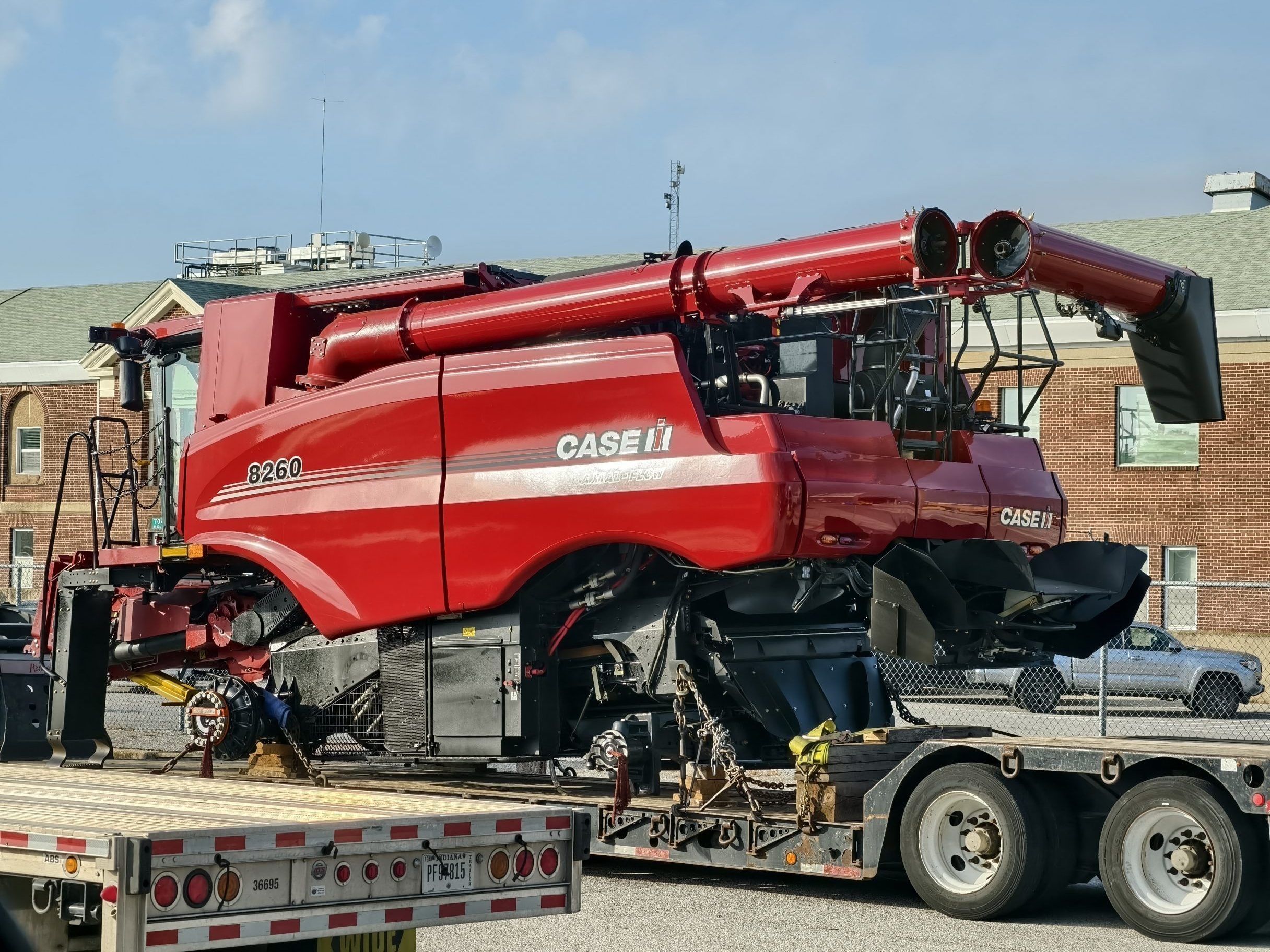
Anyway, I’ve been hiring A-1 Escort in Baltimore for this purpose since 2021, and the company has always been great to me.
If having all of this paperwork and having to hire an escort wasn’t crazy enough for you, then there’s the whole time window. In my case, I picked up my car from Shed 12 at the Dundalk Marine Terminal, which is operated by Ports America. The port allows pickups from 8 a.m. to 3:30 p.m. each workday, with ga ap between 11:45 a.m. and 1 p.m. for lunch. This results in a mad rush in the morning and the afternoon as shippers and importers try to pick up their goods in the narrow windows. All this really means for you is that you might have to wait an hour or so before an escort will become available to take you into the port. I recommend getting to your escort before the port opens and being at the gate at 8 a.m. sharp to avoid the lines.
The Payoff
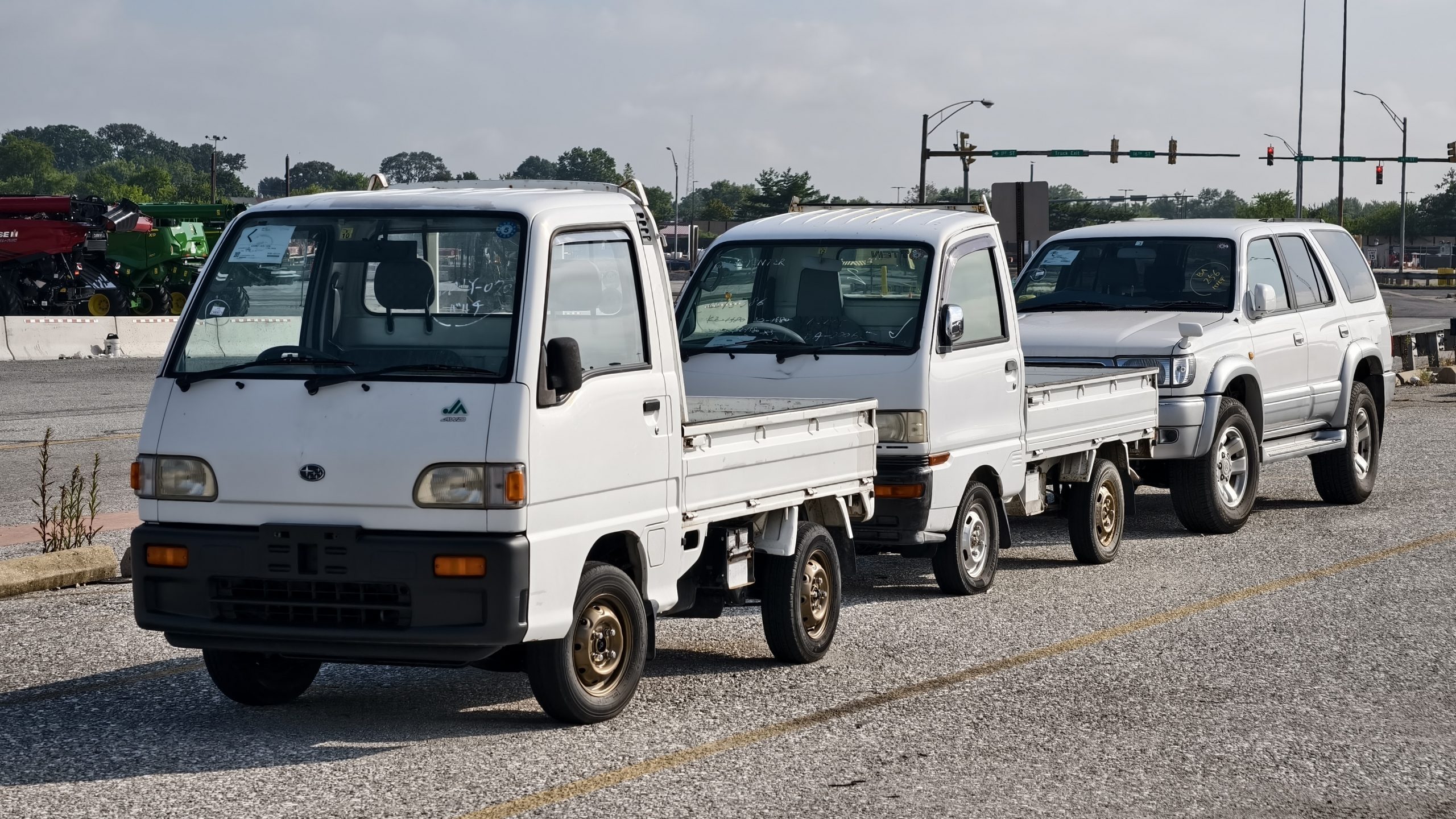
Once you’re through the gate, you’ll likely drive over to the office of whichever port operator is storing your car. You’ll present your Delivery Order as well as your gate pass, and if everything comes through clear, you’ll put on a high-visibility jacket and get unleashed into the yard.
This is where you’ll feel like a kid in a candy store. It’ll be easy to get distracted by the endless rows of brand-new cabover trucks, glistening tractors waiting to be sent off overseas, and all kinds of new cars that are fresh off the boat and ready to be shipped to dealers.
If that wasn’t distracting enough, then you get to see the majestic ships that are responsible for much of global trade. Lots of these ships will be your standard container ships or roll-on roll-off vessels, but you might spot an oddball or a few. This really neat ship is the Grimaldi Lines Grande Lagos. This ship is designed as a container roll-on roll-off ship, also known as a ConRo. These ships try to be the best of both worlds as they have the ability to carry both vehicles and standardized containers.
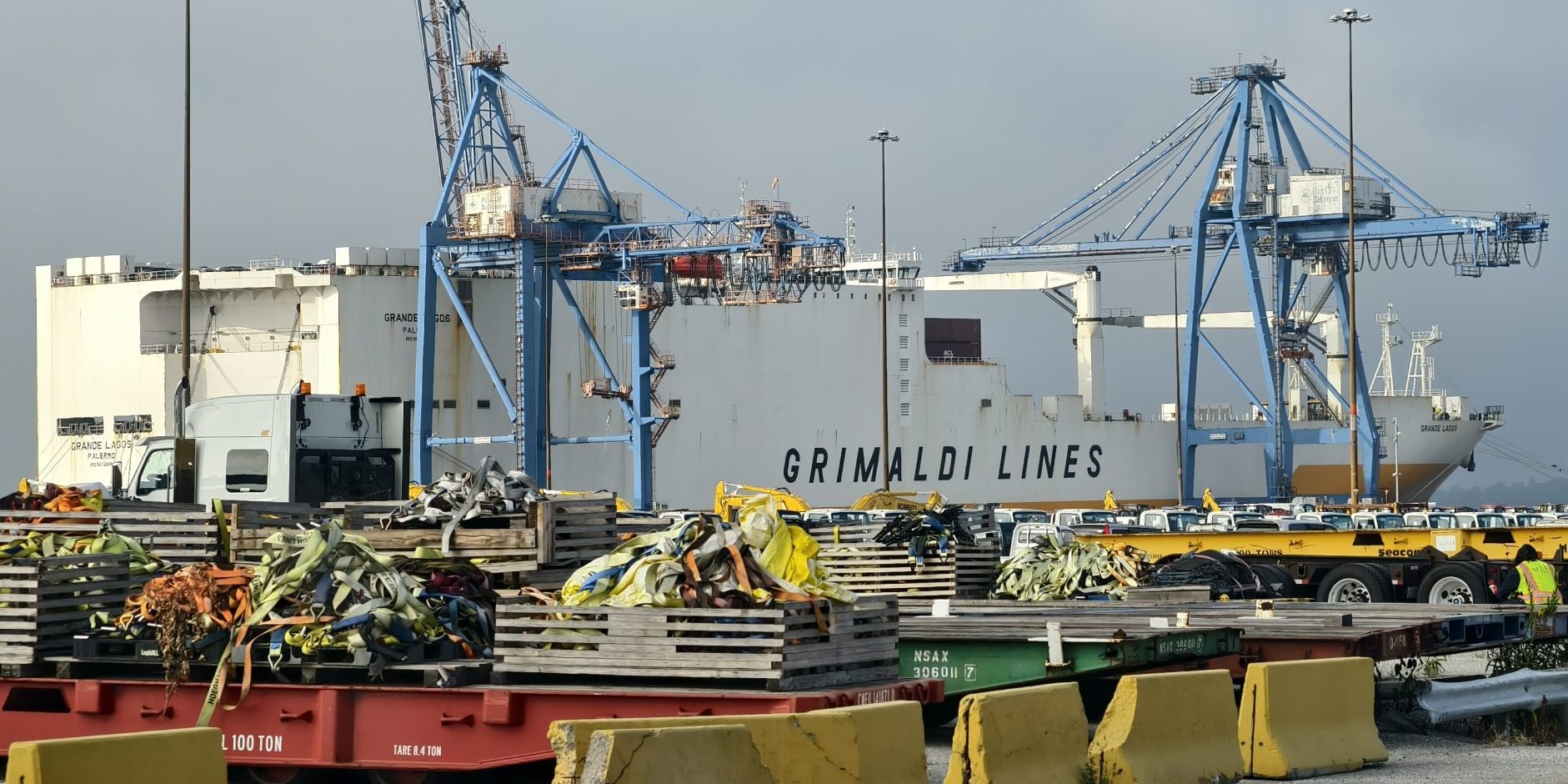
The ConRo is a versatile ship, but it has a couple of limitations. These ships are most efficient when they arrive at ports that can deal with both roll-on roll-off cargo and container cargo from the same ship. ConRos also cannot carry nearly as many vehicles or containers as dedicated ships can. These ships can often be found serving island nations, short sea shipping, or other scenarios where there is a demand for mixed cargo.
What’s also interesting is that these ships don’t always look the same. Also at the port was the ACL Atlantic Sea, which is a ConRo, but one where its main freight is containers. The cars are stored below decks. If you’re lucky, you might get to witness stevedores driving cars onto the ship!
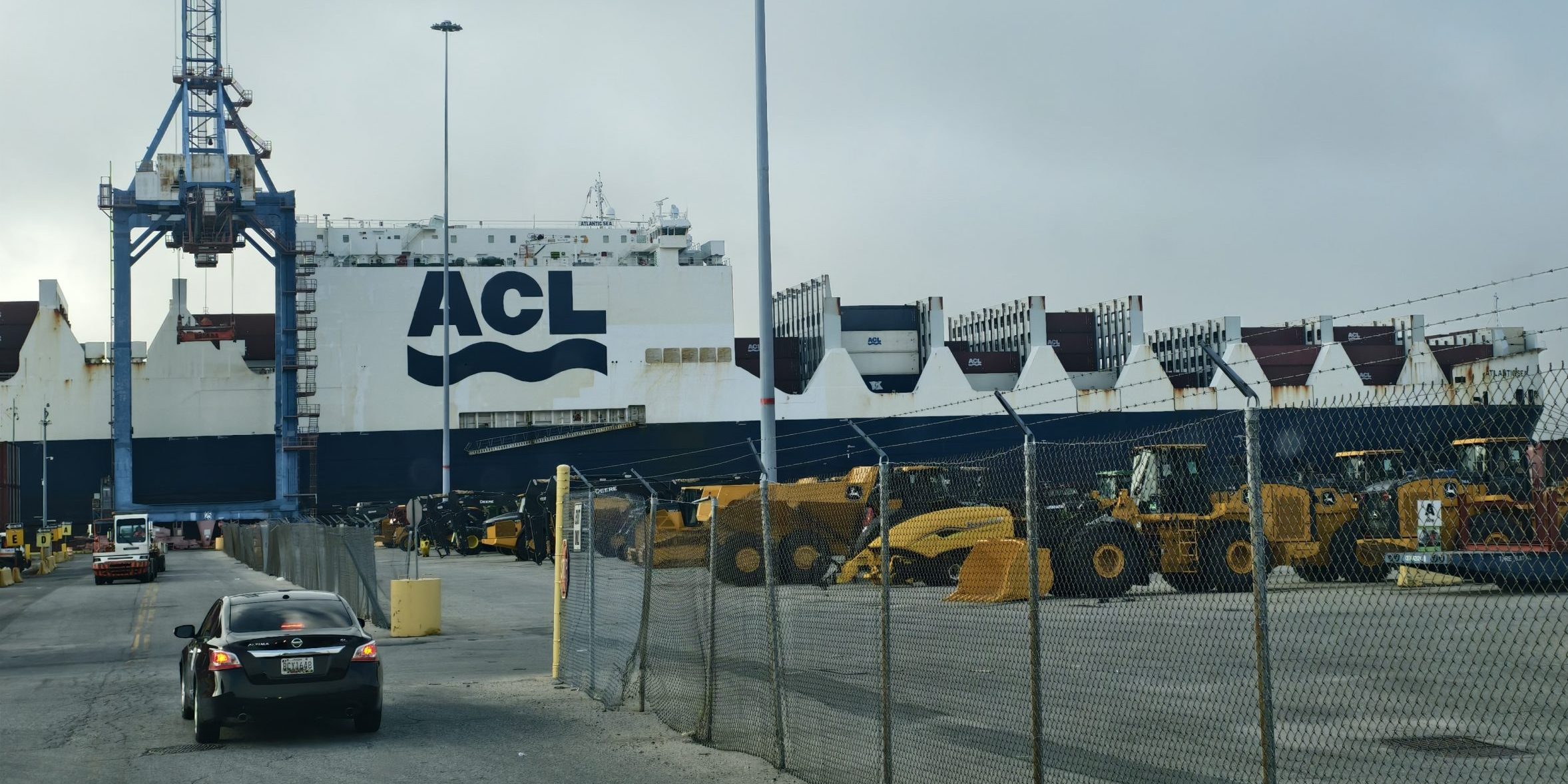
Once you’ve had enough of staring at the massive ships, you get to look at sweet imported cars. There are car lots all over the port, and the one at Shed 12 was actually one of the smaller ones.
This area is truly something exciting. You get to see all of the cool cars that people have imported, and honestly, the variety is amazing.
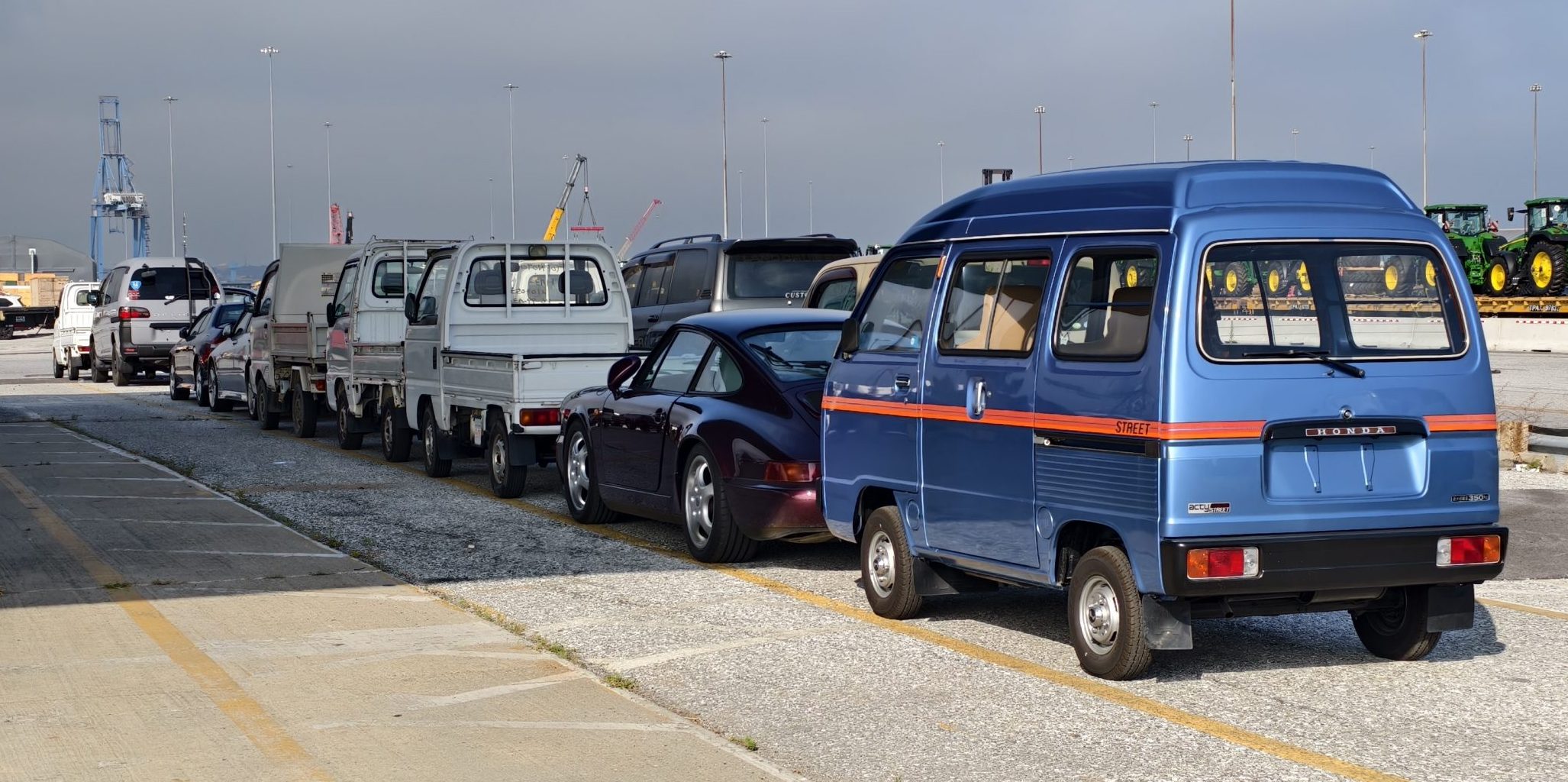
Sure, you’ll see the usual suspects like the Toyota Crown, Toyota Century, Nissan Skyline, and countless Kei trucks, but then there are some real oddballs.
Check out this rusty Dodge Ram 2500, which came from the United Kingdom. Note how the original reverse lights were converted into amber turn signals.
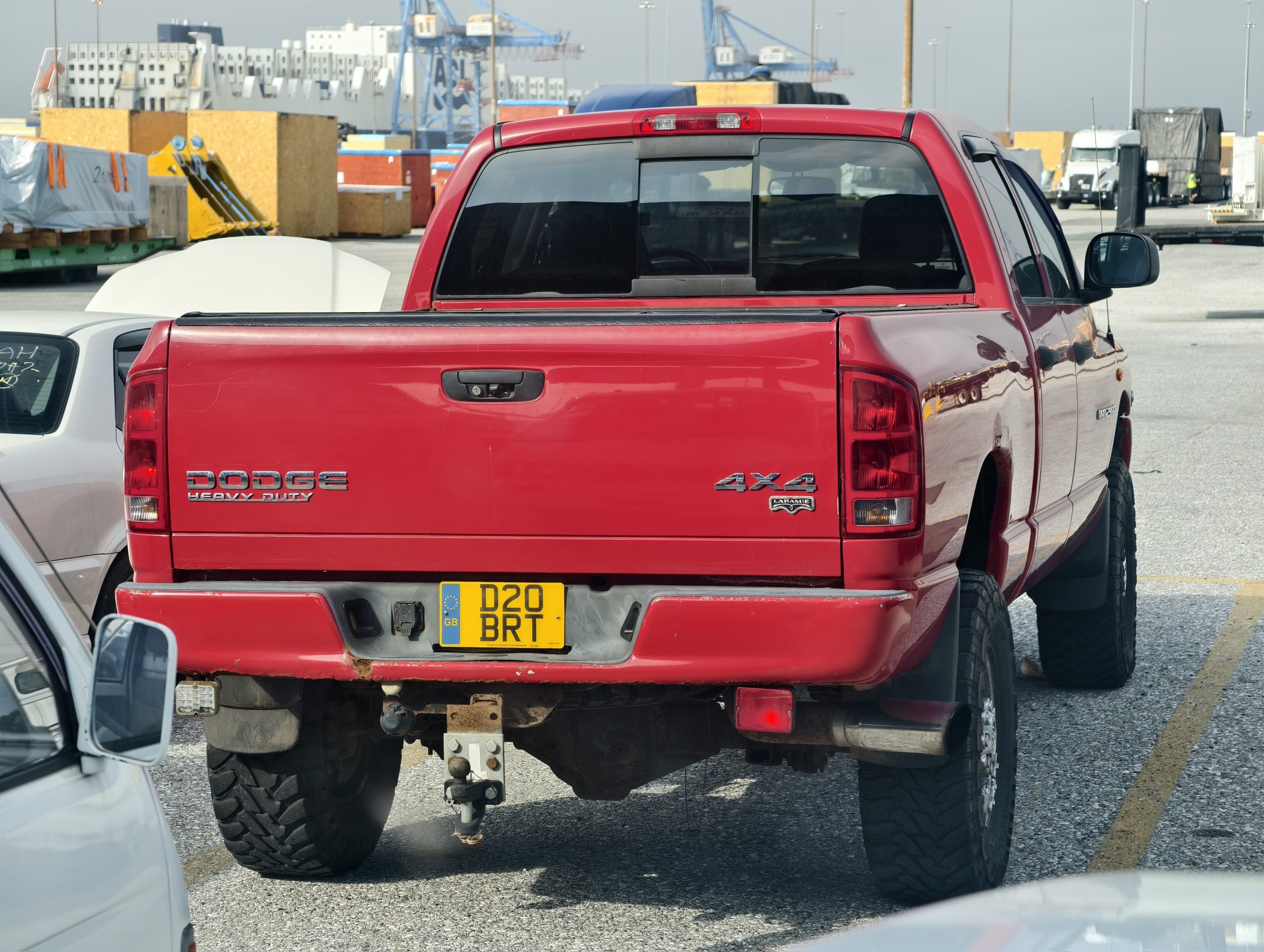
Then there’s this Japanese market Nissan Cube!
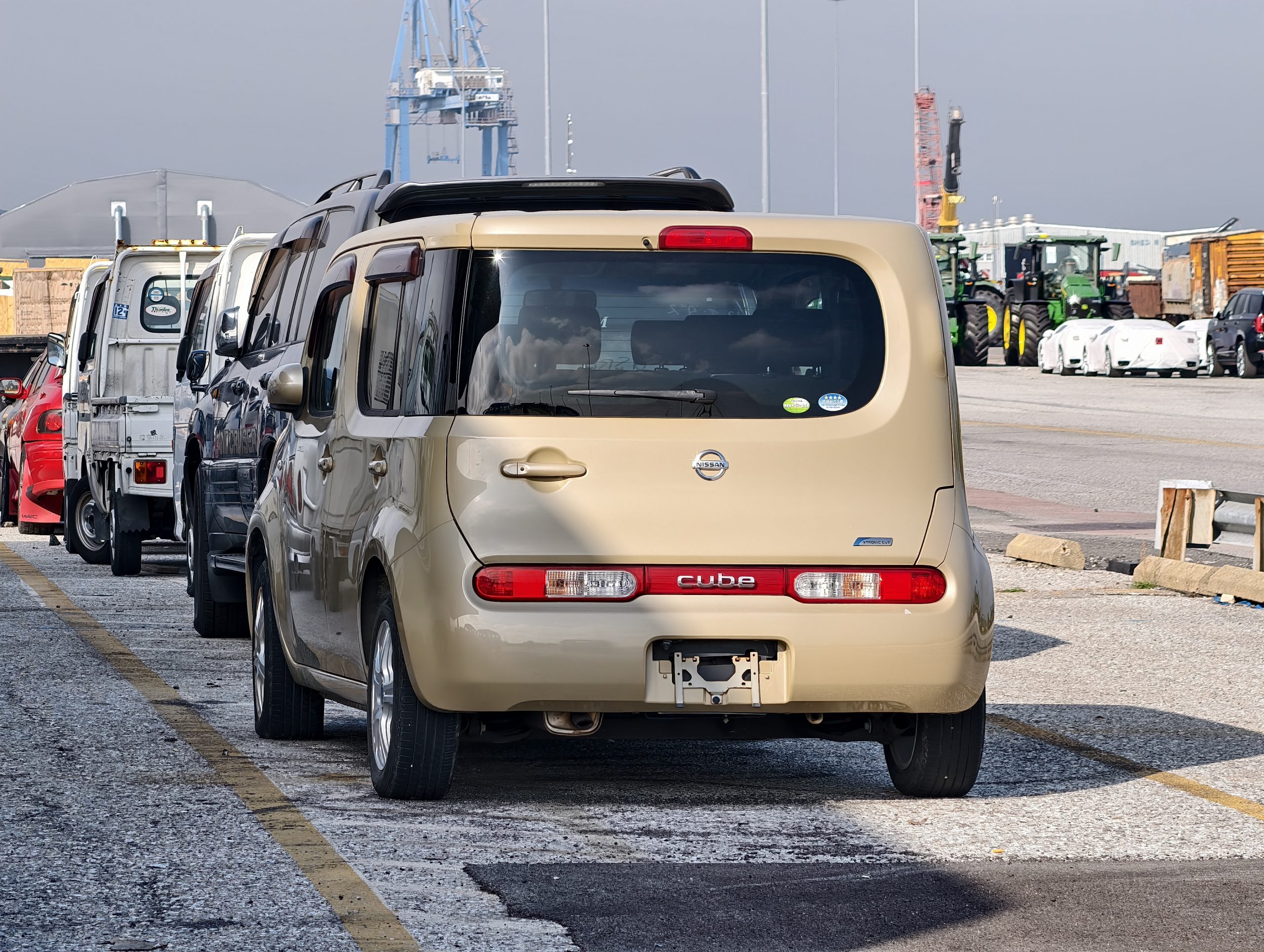
My photos show that this car was parked at the Shed 12 lot back in May when I picked up my Honda Life. I wonder why it’s still here? The second-generation Cube launched in 2008, so I wonder if this car’s legality might be up in the air.
This Suzuki Carry has also been sitting in the port for quite a while.
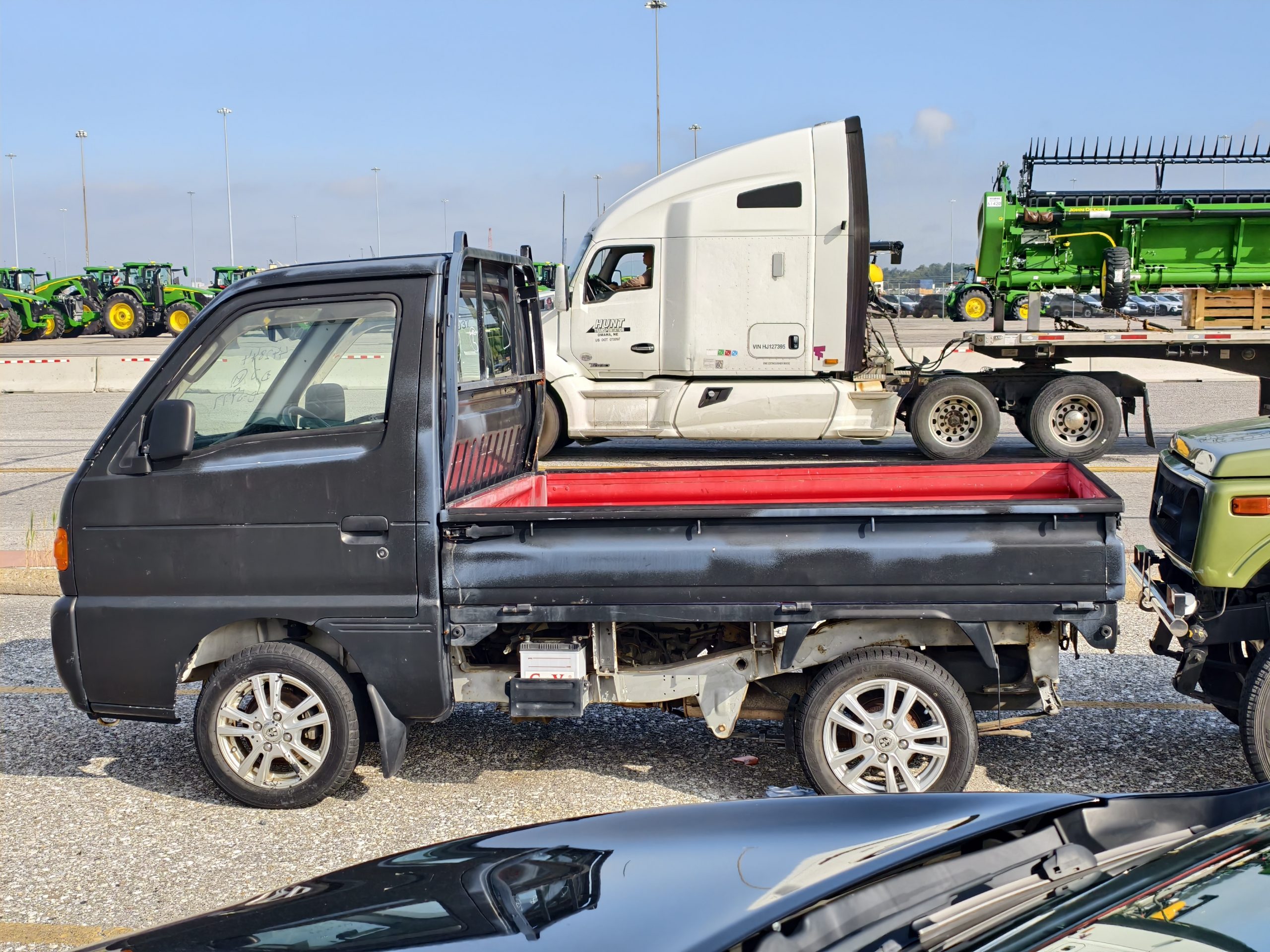
Most of the cars in the lot are going to be JDM stuff, but there’s also usually a smattering of Euro fare, usually Minis, Porsches, Ferraris, and the occasional Fiat.
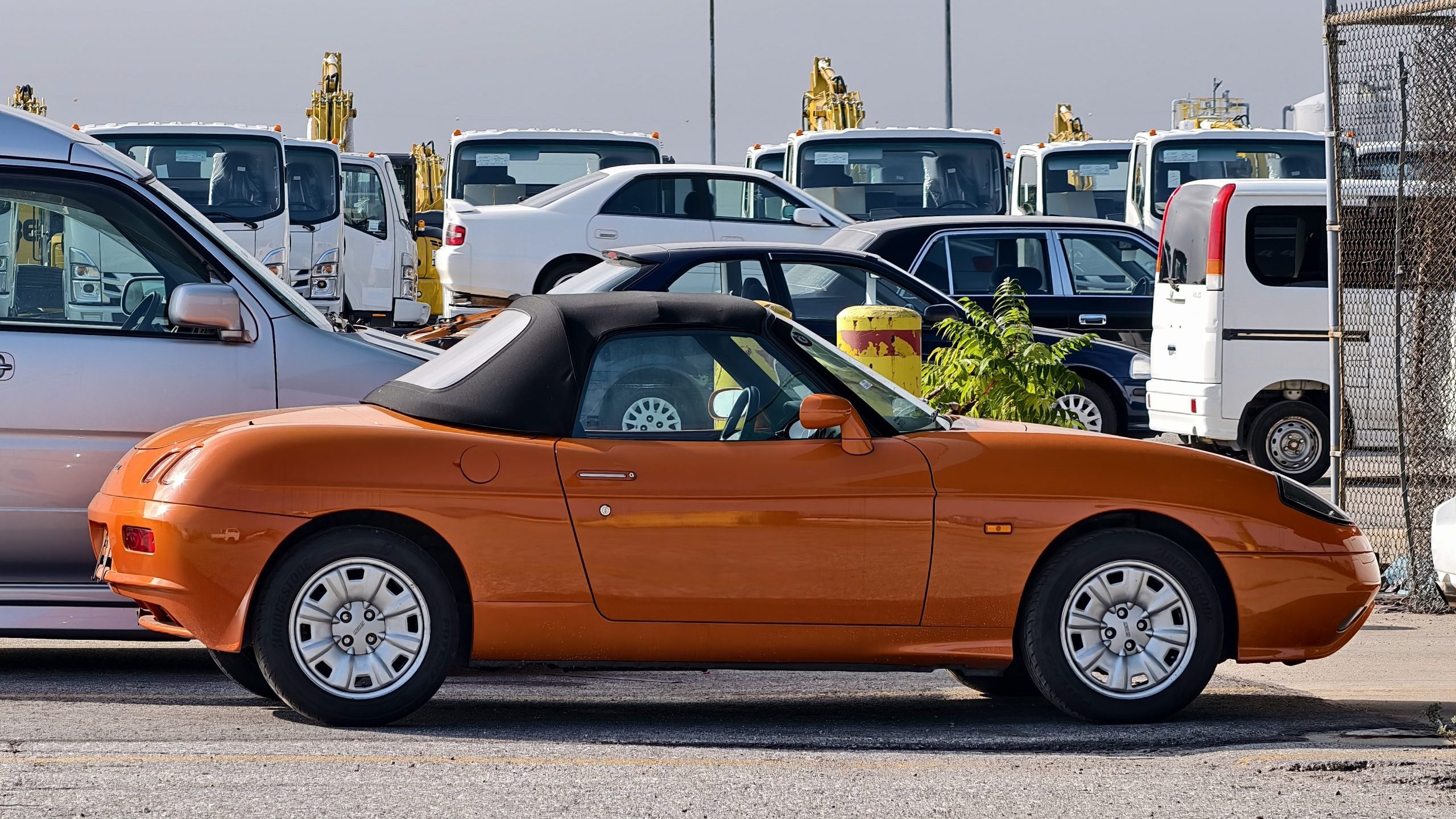
Now, you may wonder about how these cars are spaced. The stevedores sometimes pack these cars in like sardines, and I bet you’re wondering how you’re supposed to get your car out. The simple answer is that this is really easy because all of the cars are unlocked and the keys are in them. If a car is blocking your way, you just hop into it and move it.
Ideally, this isn’t a problem because the general public doesn’t have any access to this area. A representative also checks to make sure you’re picking up the right vehicle and not just any one you want.
In practice, it’s a bit more muddy. Any person picking up their car can hop into the car that you just imported and bump it into another car while moving it. Theft is also rampant in the yards, with people snatching shift knobs and other interesting parts. This is part of why you can’t ship cars with spare parts in the trunk. If you’re shipping a car with some sort of easily removable and desirable part, it’s probably best to have that part removed and shipped separately before your car is loaded onto a ship.
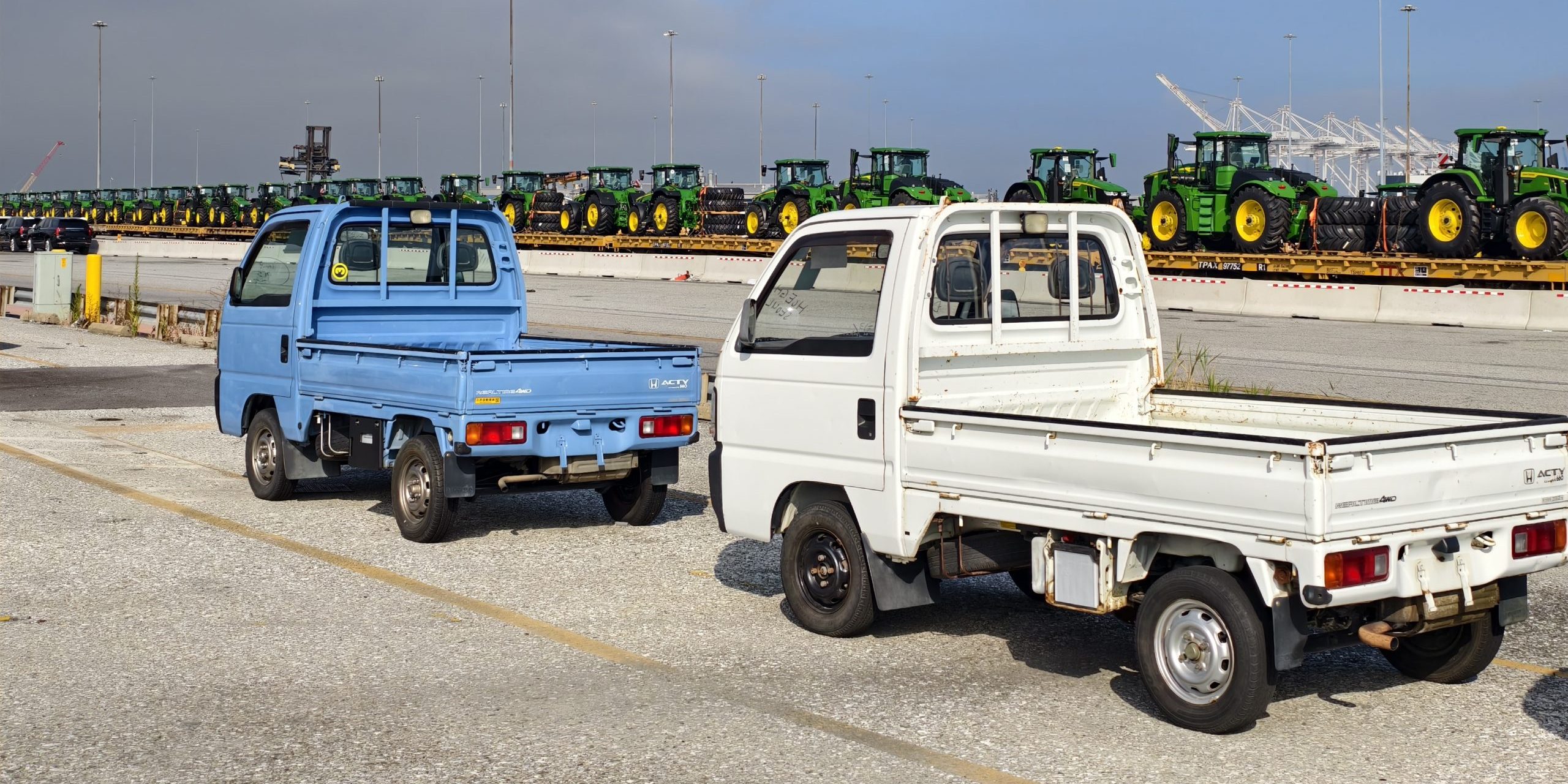
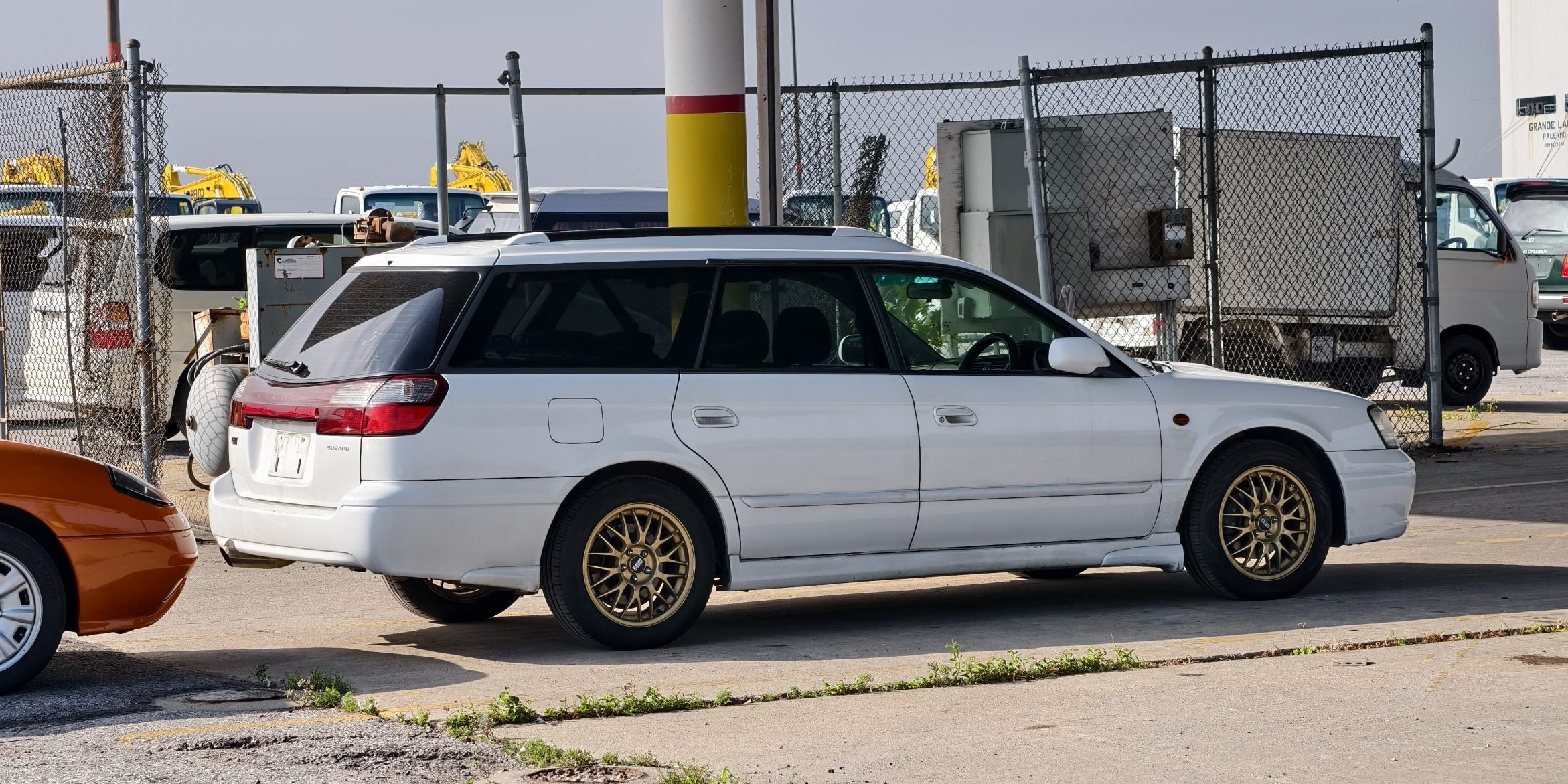
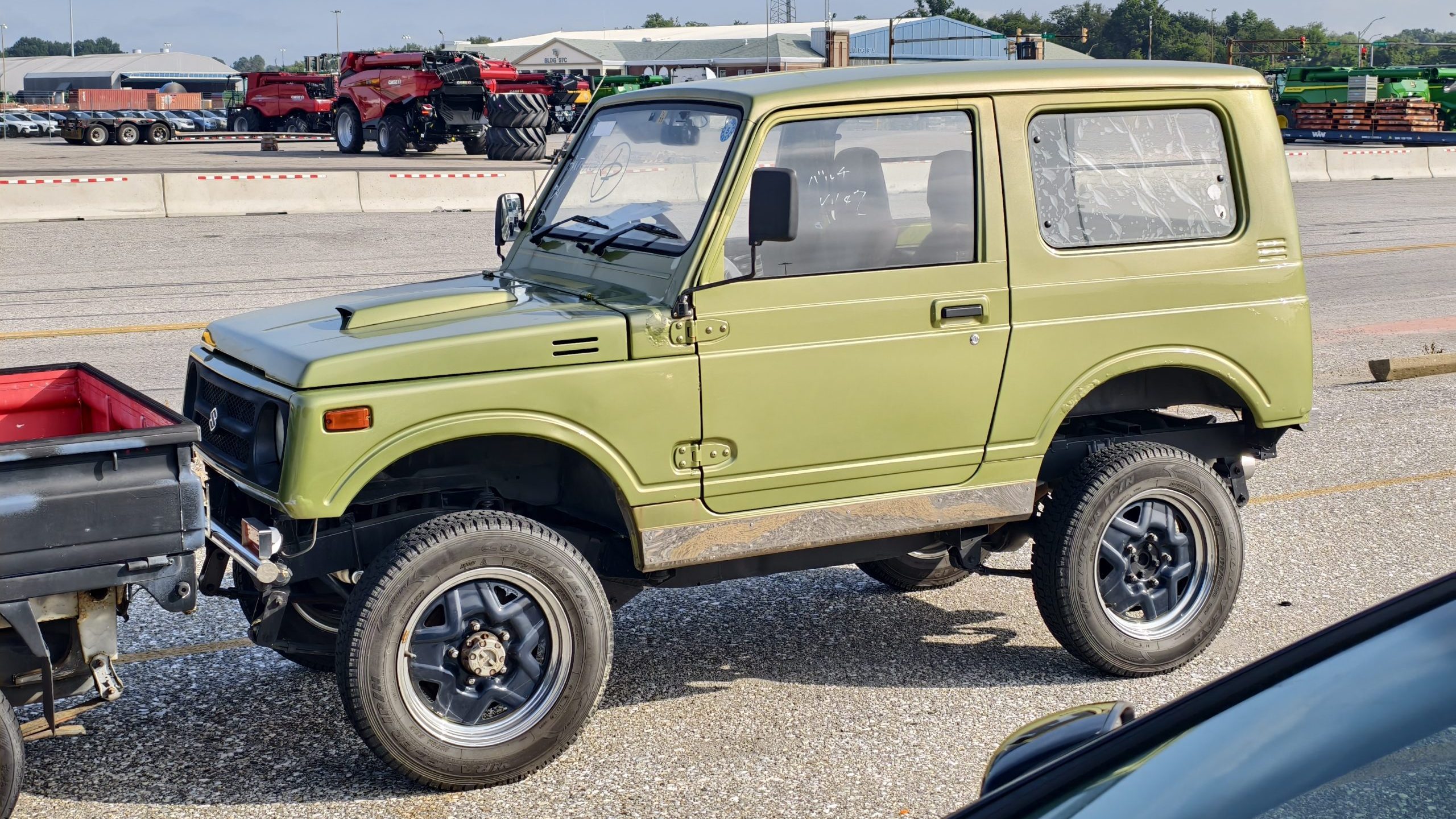
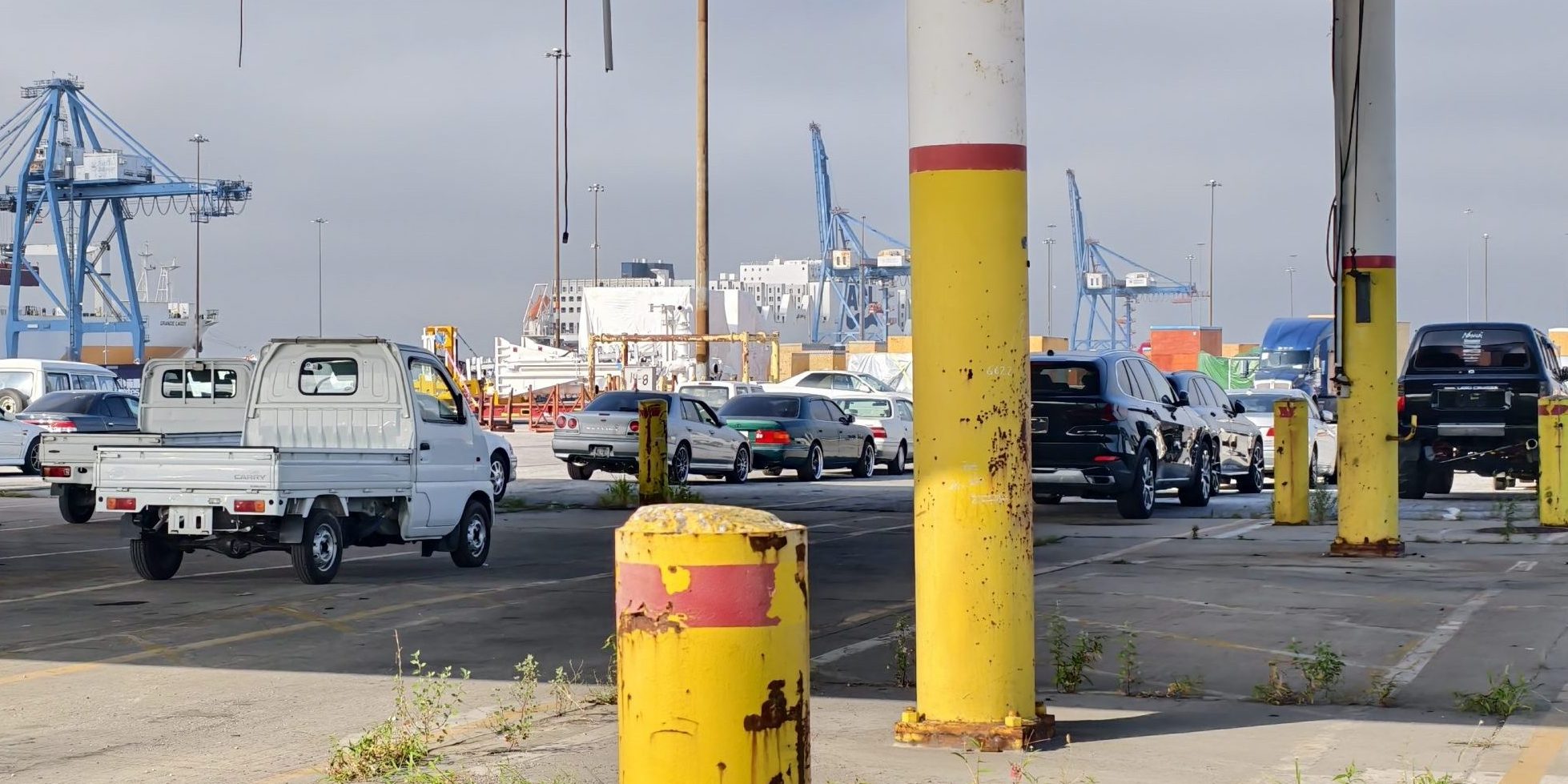
What I found at Shed 12 this year was cool, but what I found back in 2021 at the other side of the Dundalk terminal was even cooler. Check these out:
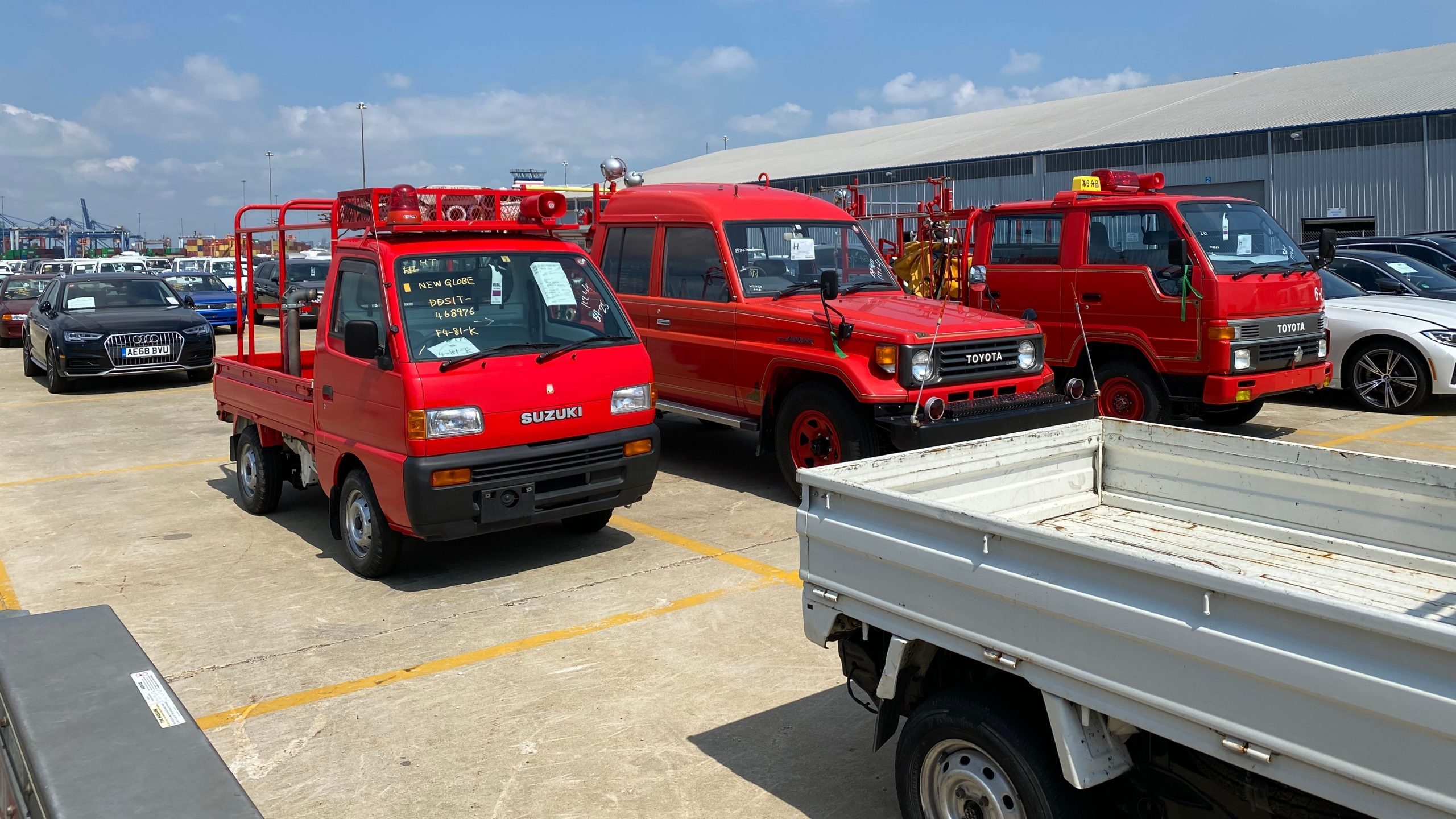
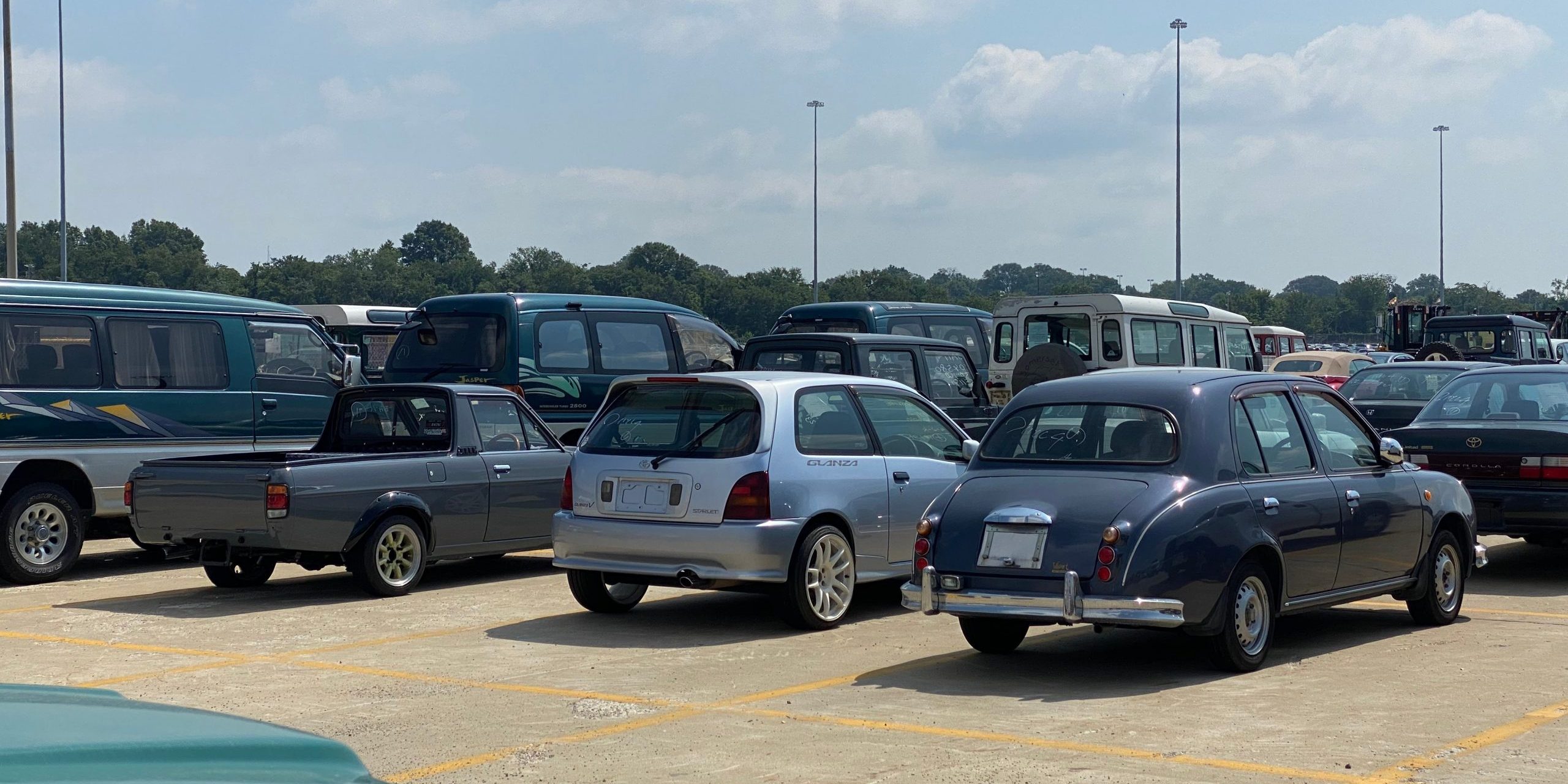
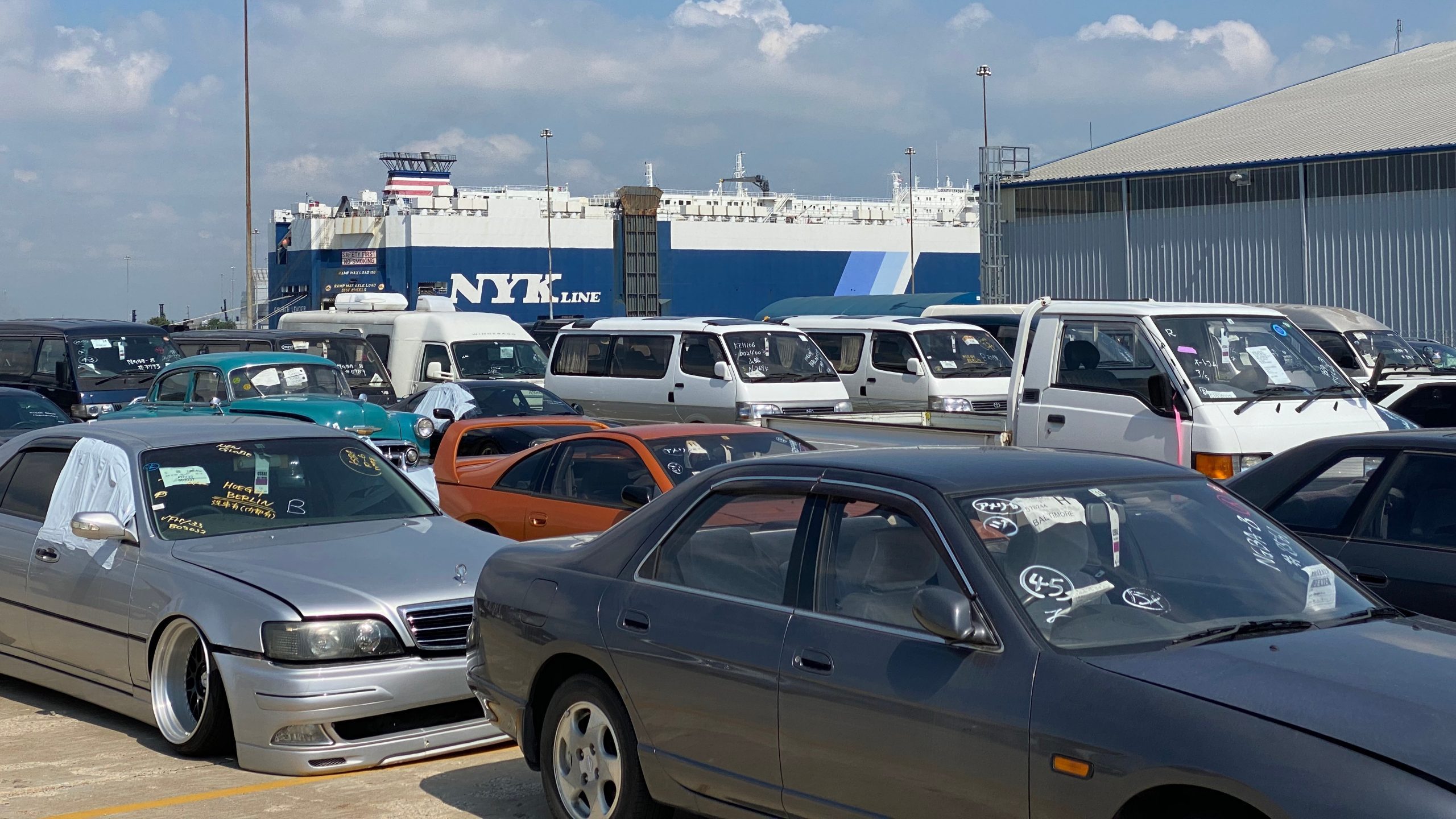
You may also wonder why I have only random, somewhat unfocused shots for some of these cars, and that’s due to time. You’re on a timer when you’re in the port, and you’re paying your escort for their time. You’re not really supposed to be messing around, going car-spotting, and filming videos for social media, but loading up and getting on your way.
The timer doesn’t stop until you’re ready to leave. Remember, your escort is probably going to go on another call immediately after you’re outside of the gate, so the more time you spend messing around, is more time someone else has to wait. I’ll snap a few pictures while I’m loading up, but I’m not going to walk around the lot with my camera.
One more note I have is that you shouldn’t be surprised to find your car covered in dirt and with a dead battery. Remember that while your car is given a very basic exterior cleaning at its departure port, it’s going to sit in a ship for a month and then sit in the port. It’s going to get dirty, and depending on your car, sitting in a ship for a month or longer will be long enough to kill its battery. Thankfully, you are allowed to bring tools into the port, and the port also has guys driving around with jump packs and other basic tools.
Every Enthusiast Should Go To A Port
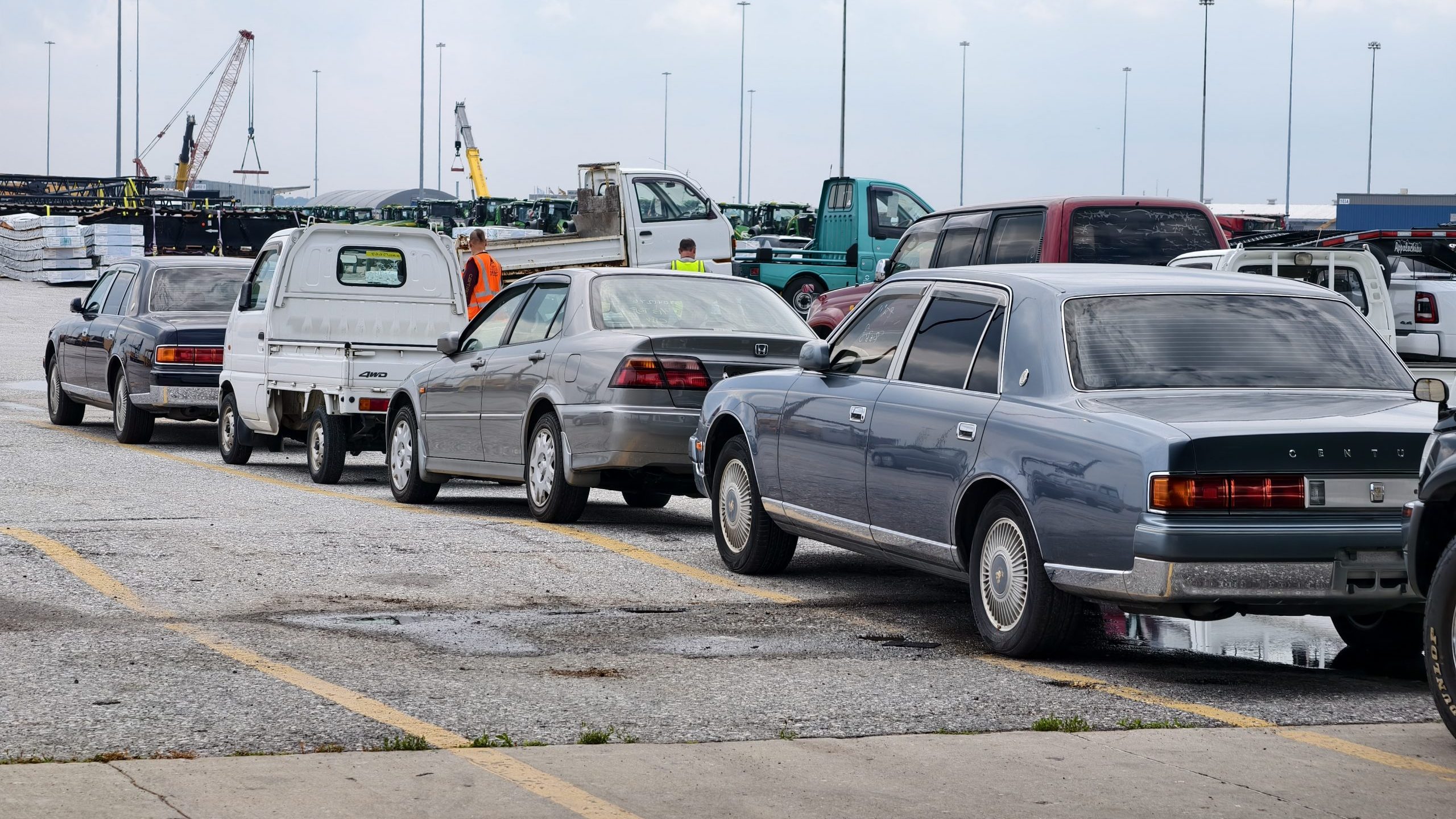
The whole port experience is absurd when you think about it. There’s a mountain of paperwork, you have to brandish your credit card seemingly every few minutes, and someone has to babysit you while you’re in there. Oh, and you’re picking up a car that, until that moment, you have likely seen only in low-resolution photos and certainly didn’t even test drive. Your first moment ever driving this car is when you’re loading it onto your trailer. You have to do all of this in a short timeframe, too. It’s enough to stress anyone out.
Yet, I think going to the port is an amazing experience. You get to witness the mechanisms of global trade with your own eyes. You get to look at huge ships and cool cars while working with folks who honestly have some really awesome jobs. My escort told me that there’s always something awesome going on in the port, from people importing racing boats to people importing cars you’ve never seen before.
Really, going to the port is an experience that perhaps most car enthusiasts should go through at least once. It’s so fun and so different than anything else that it’s something that you won’t forget. The next time you import a car, forget about paying a shipper; go to the port yourself!

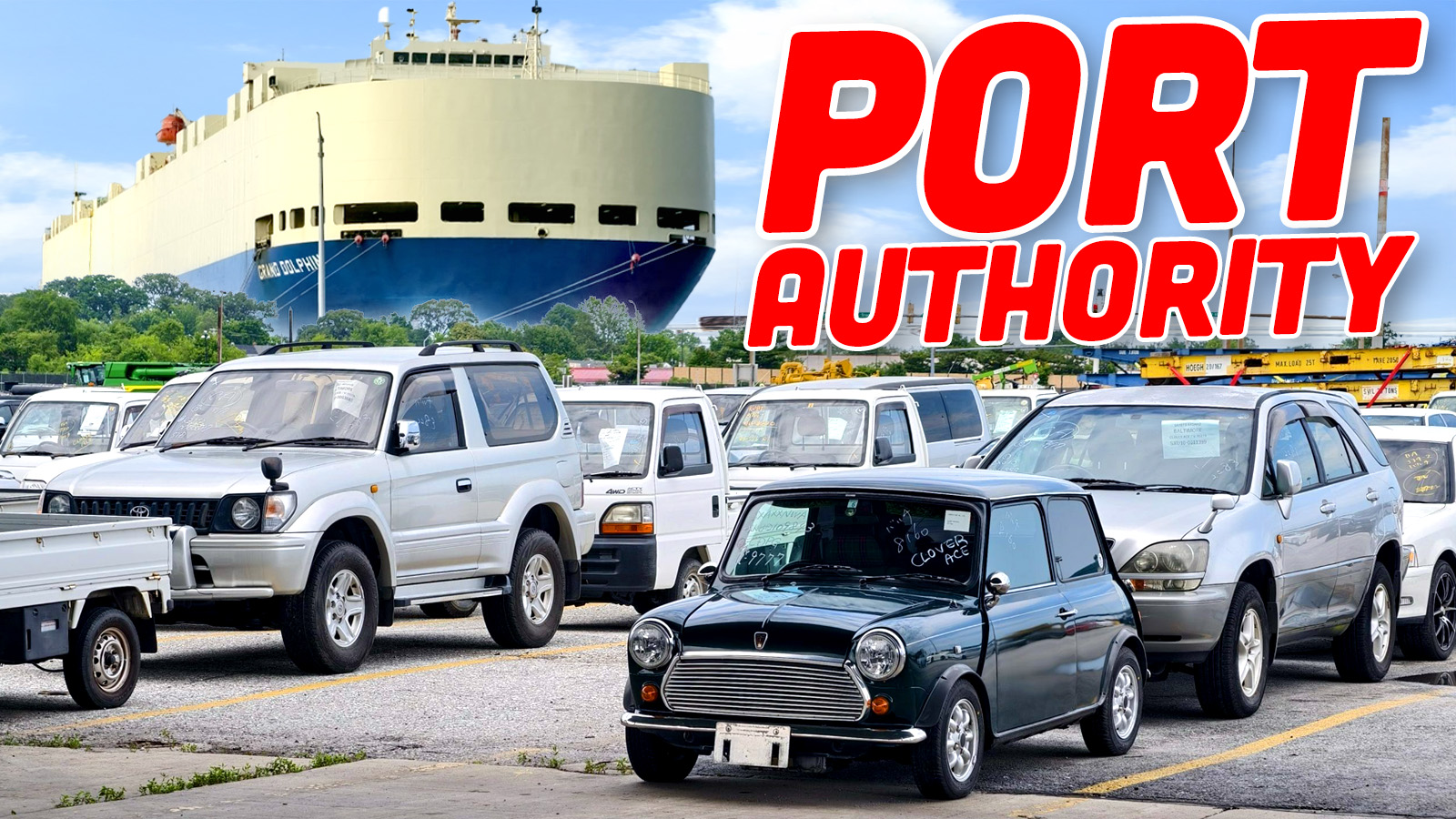







“In practice, it’s a bit more muddy. Any person picking up their car can hop into the car that you just imported and bump it into another car while moving it. Theft is also rampant in the yards, with people snatching shift knobs and other interesting parts. This is part of why you can’t ship cars with spare parts in the trunk. If you’re shipping a car with some sort of easily removable and desirable part, it’s probably best to have that part removed and shipped separately before your car is loaded onto a ship.”
I think we have all seen season 2 of The Wire.
I’m sorry, but in this era of clickbait headlines, why is this article not called “Why I Went to Down to the Docks in Baltimore and Hired an Escort by the Hour”?
This is the best comment I will see all day. bravo.
That Cube is easily the most sophisticated vehicle at that port. The badge on the rear tells us the whole story there.
Glad you got the MG – drove one years ago and it was stupendous. I also love your appreciation of the people assisting you in the port. Like myself, working in the railway in Scotland, all they have to do is get the people or cars in and out of the place ASAP so the next one is able to get in. Was that a Toyota Century in one of the later pix? Love them.
There is two Centurys (Centuries?) in the last photo.
Can’t wait until I get to import a car. Picking it up at the port was always going to be the highlight to me and this just reinforces that. Maybe I should consider a career change and become a port escort.
Can confirm ports make for great car spotting. When I dropped my car off at Yokohama for shipping the parking lot was just as interesting as Mercedes describes. Also saw some guy painting an old Camry just a few feet away from a new Lamborghini!
That doesn’t sound sketchy at all…
Easily one of the sketchiest places in Japan (and off the regular tourist track, things can get weird there!)
“In the Port of Amsterdam…….” etc.
Has anyone picked up at Jacksonville? I’m on the fence about importing a car. Just wondering how easy it is there vs other ports.
As the husband of an MGB owner, I look forward to hearing about your new cheap British roadster. (And maybe even seeing it next year at the British Car Field Day in Sussex, WI on Father’s day!)
The Sussex show is a great show! Do they still meet in the bowl shaped park?
Yes!
When I was flying gliders, I bought part or all of three new gliders carbon/glass composite gliders manufactured in Slovenia, Germany, and Lithuania. All came in weather proof trailers, 30 to 35 ft long, single or dual axle. First two came on RoRo ships from Germany, requiring a road trip down to Port Hueneme near LA to pick them up. Mostly new German cars, a few random older ones, but the one thing that struck me is that there seems to be a market for multiple older German fire trucks on the west coast. Last one came by itself in a container directly to Oakland, it was actually cheaper that way, I’m not sure why this wasn’t done more generally.
Reminds of when Ziggy and Johnny Fifty stole those Mercedes for the Greeks.
Repost. If you’re visiting the Port of Baltimore you should keep an eye out for the US military ships that carry cars.
—————
Mercedes, I’m not sure at which pier in Baltimore your car will be offloaded or at which lot it will be stored, but you’ll be in the neighborhood to see two of the fastest car carriers ever built. Near Fort McHenry (you should visit!), you may notice some unusual-looking RO/ROs painted in haze grey. Difficult to explain various complexities here, but those are ships managed by DOT’s Maritime Admininistration (MARAD) and Navy’s Military Sealift Command (MSC), kept partially operable to keep down costs, but ready to be deployed in as few as five days.
Several of them, the Algol-Class Fast Sealift Ships are still (in theory – they’re old) powered by steam and can steam at (in theory – they’re old) more than 35 miles an hour, which makes them among the fastest cargo ships ever built. Originally built as container ships – so, NOT blocky – but sold as too expensive to operate, bought by the US Navy, and then converted to car carriers. The fleet of various types of ships transports the vehicles of Army armored divisions in wartime. On her first voyage the owners of the then-SS Algol tried to set an all-time record for an Atlantic crossing, but lost to the record set by the SS United States by just a knot, still a record for a cargo ship.
https://i0.wp.com/baltimoreshipspotting.com/wp-content/uploads/2019/01/46322805942_c03f00b9d1_k.jpg
I just remembered: a long time ago my buddy ordered a first-generation Saab 900 Turbo directly from the factory. She knew which ship it was on, and it arrived in Baltimore for pick up – just in time for a massive East Coast dockworker’s strike. For a few weeks she could see the ship her car was on anchored out, every day, unable to come pierside and deliver her new baby.
The Port of Baltimore is still the biggest car delivery port in the US, I think. Near easy connections to highways and rail, 700 acres of parking, lightly-loaded carriers can easily make it up the relatively shallow Chesapeake Bay.
https://www.google.com/maps/place/RO-RO+%2F+CAR+Terminal,+Port+Of+Baltimore/@39.2496208,-76.5345983,1772m/data=!3m1!1e3!4m6!3m5!1s0x89c801488dc9e0d3:0xc89c38a9f07509aa!8m2!3d39.2496208!4d-76.5320234!16s%2Fg%2F11tbxsgx5f?entry=ttu&g_ep=EgoyMDI1MDUwMy4wIKXMDSoASAFQAw%3D%3D
Great article. But I have to ask, why would someone import a Ram pickup.
My guess is that it has very low miles and was available for a very low price. In the UK cars depreciate very quickly compared to the U.S. If you are looking for a particular truck and find it with half the miles and less than half the price of buying it locally, then it would certainly be worth it to bring it back home!
We need more stories by people who imported a vehicle, describing their crazy experiences and memories about the process.
This sounds like my actual nightmare
Hmm. I live south and west of Baltimore, and have been noticing a huge uptick in the number of Kei cars around here as a result of all the imports coming through here. As much as I’d love to buy a little carryall truck, the wife would kill me if I dragged something else home. However, it would be a lot of fun to go visit the port….
I’d like to see an index of all of Mercedes’ car importing articles. Somewhere out there is a 90’s Toyota Hilux Diesel 4-door that will be mine, and I hope I can find all these awesome stories again.
Another great article, keep up the good work Mercedes!
I mean, you could go visit a port, or you can just visit via YouTube. I watch a kei car channel called “Way Before the Fame” – I’m sure there are plenty of others – who does port tour videos several times a year, and you don’t need an “escort” to watch them!
Very true! But honestly, there are some things that videos don’t convey well, and a port is one of those things. It’s amazing to watch a port work, if only just for an hour.
You’re right, but near as I can tell, it’s costs several thousand dollars to visit a port. I don’t think you can hire an escort and wander around. I assume you have to have some business there, which would involve importing a car.
Sounds like a win-win to me. 🙂
But yeah, you are technically correct, the best kind of correct. You aren’t really getting in unless you have a reason to be there, be it for a car, tractor, boat, motorcycle, a Changli, or whatever.
I personally find it a bit amusing that on one hand you can’t get in unless you’ve jumped through hoops to get cleared or hired an escort to literally watch you while you are in there but also theft is rampant. The background checks to get a TWIC must be very thorough.
As they say, the pirates have nothing on the dockworkers…
I got a TWIC card for work a few years ago. It was pretty easy, fill out a few forms online and then go for an interview and finger prints at a local authorized office (at a shipping company just over the border in Wisconsin).
It was very similar to signing up for Global Entry or a NEXUS card from what I could tell. Quicker though, not sure if the background search is as in depth.
I think I just found a new retirement gig though, being a TWIC escort…
I want that one, and that, and that……
I ll say it again. Mercedes has the best articles.
Another gem! Happily, it sounds like this pickup was considerably less eventful than the last one.
Jason- i kinda consoles her in the comments RE the sheet show of the last time. I knew nothing could EVER be anywhere near that bad again. It s not possible-no way. Karma meter on All good for year to come.
Mmm that Subbie wagon.
Hiring an escort that gets paid by the hour? Bow chicka bow bow.
Came for this. Leaving satisfied
I hope this story has a happy ending.
YMMV
You might want to ask if ‘express release’ is available next time (of course!) – bills of lading are quite an old-fashioned way of doing things these days, and the shipping lines don’t really like them either.
Bills of Lading are documents of title – if the bill is made out ‘to order’ then whoever holds the bill of lading effectively owns the goods that it represents – they are negotiable documents, and you can use them for lots of financial purposes (including borrowing money).
They’re still used in some important niches today (for example if you have a transaction involving a letter of credit it will require a bill of lading). However, moving bits of paper around the world isn’t the most efficient method.
For most containerized shipping these days the shipping line will issue what’s called a non-negotiable sea waybill – it’s not a document of title so you don’t have to go through the hassle of putting them in the post, or indeed the faintly terrifying circumstance of losing them.
That happened to me once in extremely awkward circumstances, and it ended up costing the business I worked for $125,000…
Fascinating, thanks for the insights. And now of course we are interested in the awkward circumstances story
Naturally. The $125,000 was actually a 50% discount!
Essentially the sales guy at my business annoyed a customer in a north African country so much that he decided he didn’t want the container of dairy products we’d sent him.
We had already sent the bills of lading on to said north African country, and they were in a government office somewhere – the customer of course didn’t want to help us. Our freight forwarder didn’t have an office in this north African port so they couldn’t help either.
As Mercedes said in her story you only get a couple of days of free storage at the port before they start charging. So the charges started to rack up. What was worse was that as it was a container of dairy products they were in a refrigerated container, which was plugged in on the dock in north Africa. So the charges were something like $1000 a day and the container was sat on the dock for over six months.
We tried everything we could think of to get the container cleared but the laws in that country required the original bills to release it. Eventually the freight forwarder contacted an agent of theirs that knew a guy at the other end of the north African country, who was able to find the right person to talk to in the government.
After paying a very hefty indeminity (to protect against anyone turning up with the bills of lading and asking for the dairy products which were by now a solid block of rancid yogurt) I received a grainy smartphone photo of the container leaving the dock under police escort to be taken into the desert and set on fire.
I keep a copy of that photo on the wall to this day!
As a customs broker, seconded.
It is also sometimes called a Telex release.
I usually tell my customers to ask for an Express/Telex release, just to be safe.
Much easier and you don’t have to endorse then overnight it to the consolidator or line.
True – I just didn’t want to have to explain Telex to the young’uns!
Thanks for filling us in on the procedure, quite interesting. What is that little ute third photo up from the bottom?
Can’t see it properly but maybe a Volkswagen Caddy mk1?
Nissan Sunny Pickup
https://petrolicious.com/blogs/articles/this-datsun-proves-the-coolest-vintage-trucks-are-ones-that-were-raced?srsltid=AfmBOorwh6R8SYuio119xZEHaDqFIZSQcyxBWfAOFQy1-aRANbhpqC8S
https://carsandbids.com/auctions/36RMyLWZ/1987-nissan-sunny-truck
This is probably the best Nissan Sunny ever built…
Its up there with the Nissan Sunny California
I read the entire article in the voice of the person who narrates the “How It’s Made,” documentary series. Nice work, Mercedes. Fun read.
Two things I noticed:
1) Did Ford give you a base model Super Duty…with a real key (for unmentionable reasons)?
2) That Prado 90 shorty is HOTTTTT
Not just a base model Super Duty with a key, but they also gave me the password to this truck’s FordPass. The truck also has a winch, presumably in case someone got a U-Haul truck stuck in mud. But who would be that silly?
LOL – they really gave you the right tool this time.
Looking forward to your MGF adventures.
A real key. Fordpass. Winch. Um- not a coincedence. Thats kinda rude Ford.
Oh, that made me laugh…Thanks!
Someone at Ford has a sense of humor.
And no sunroof?